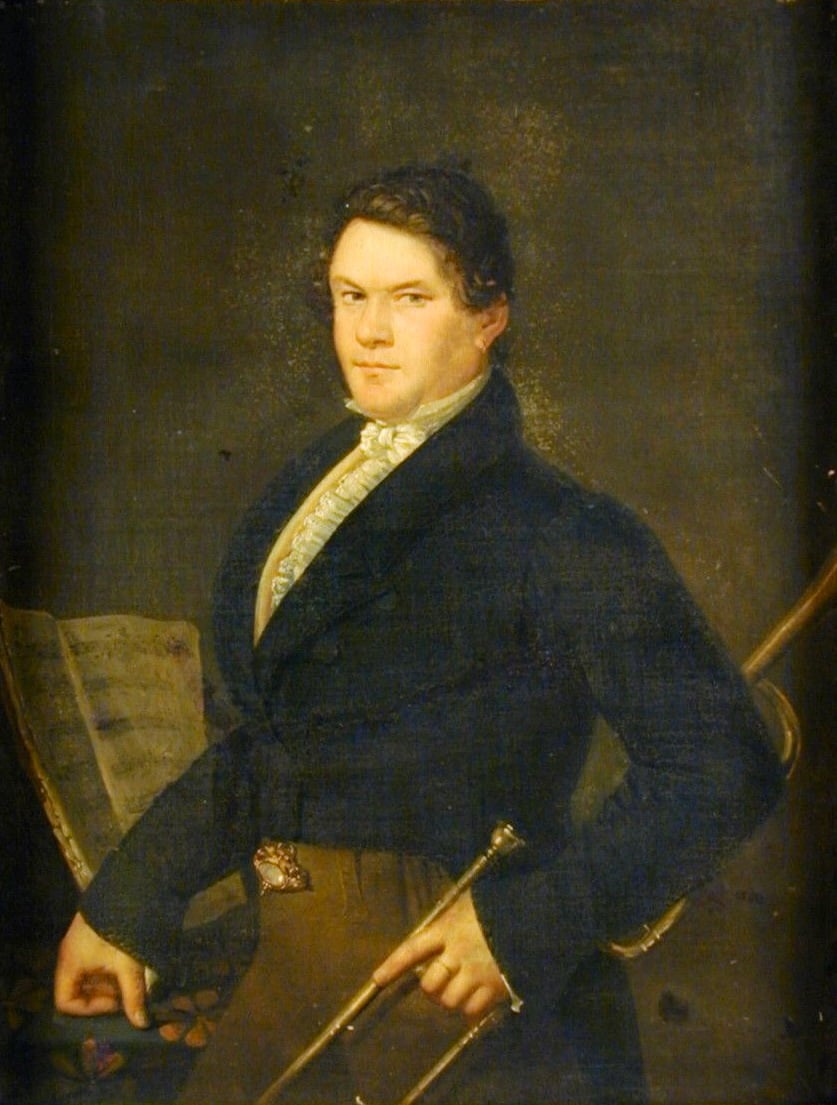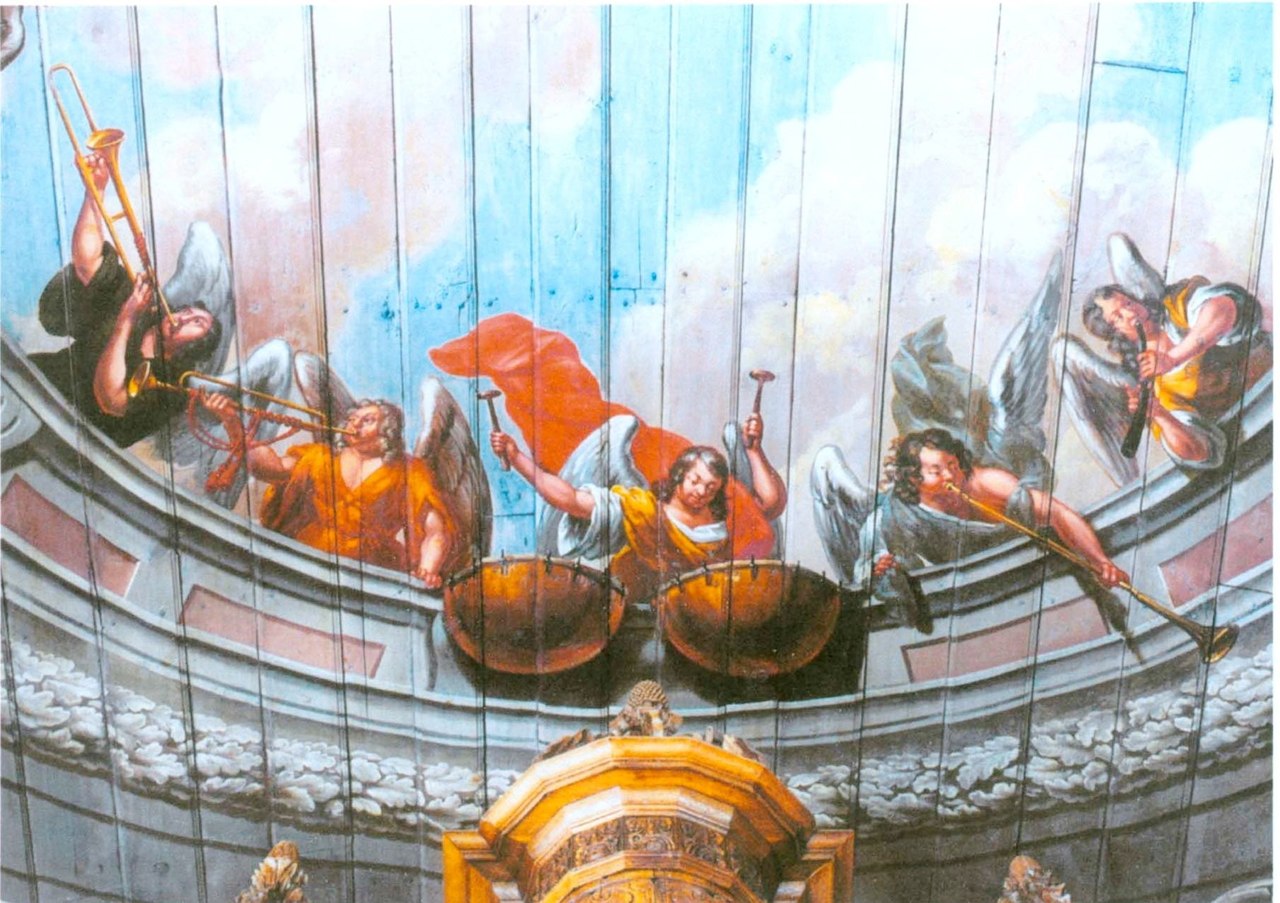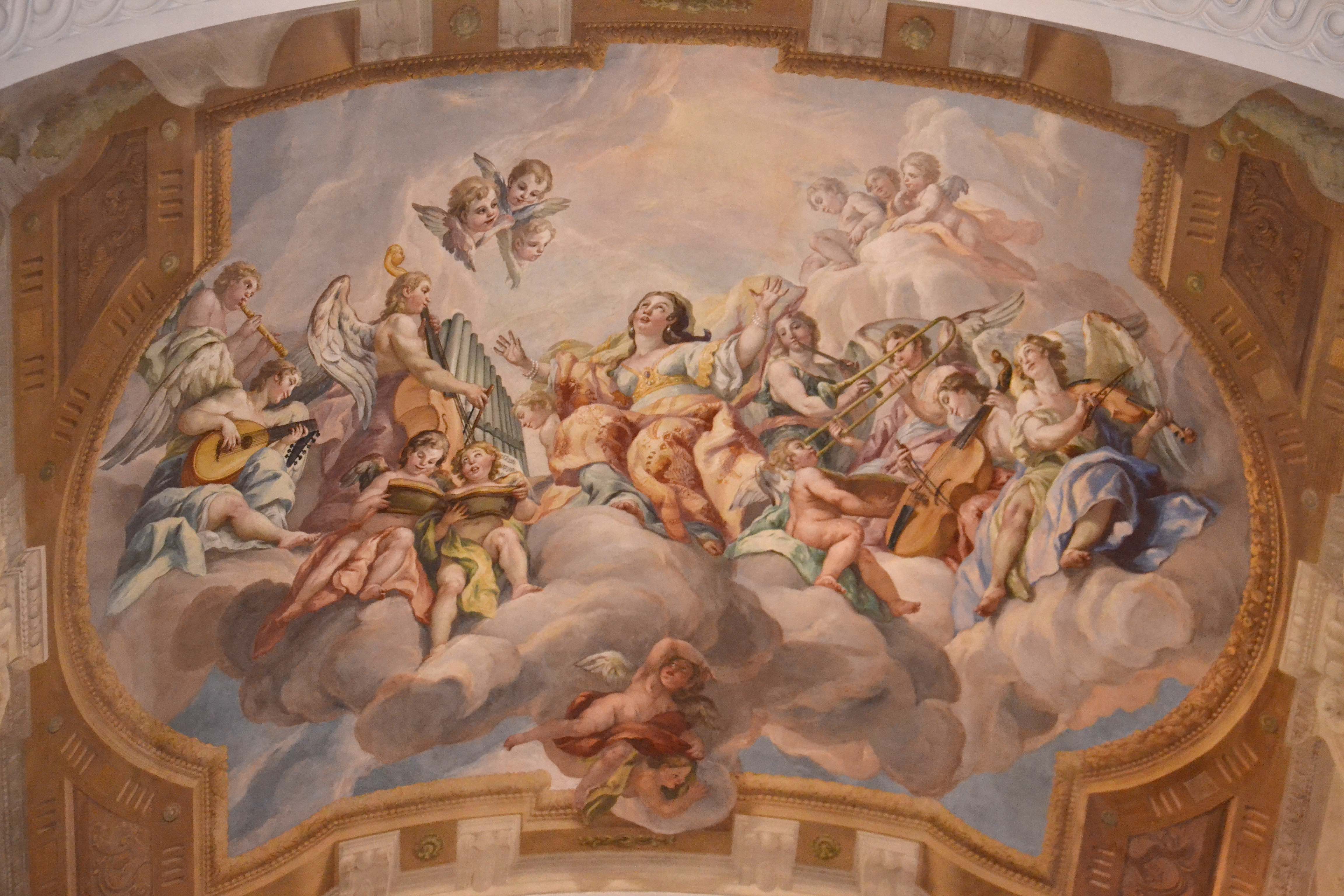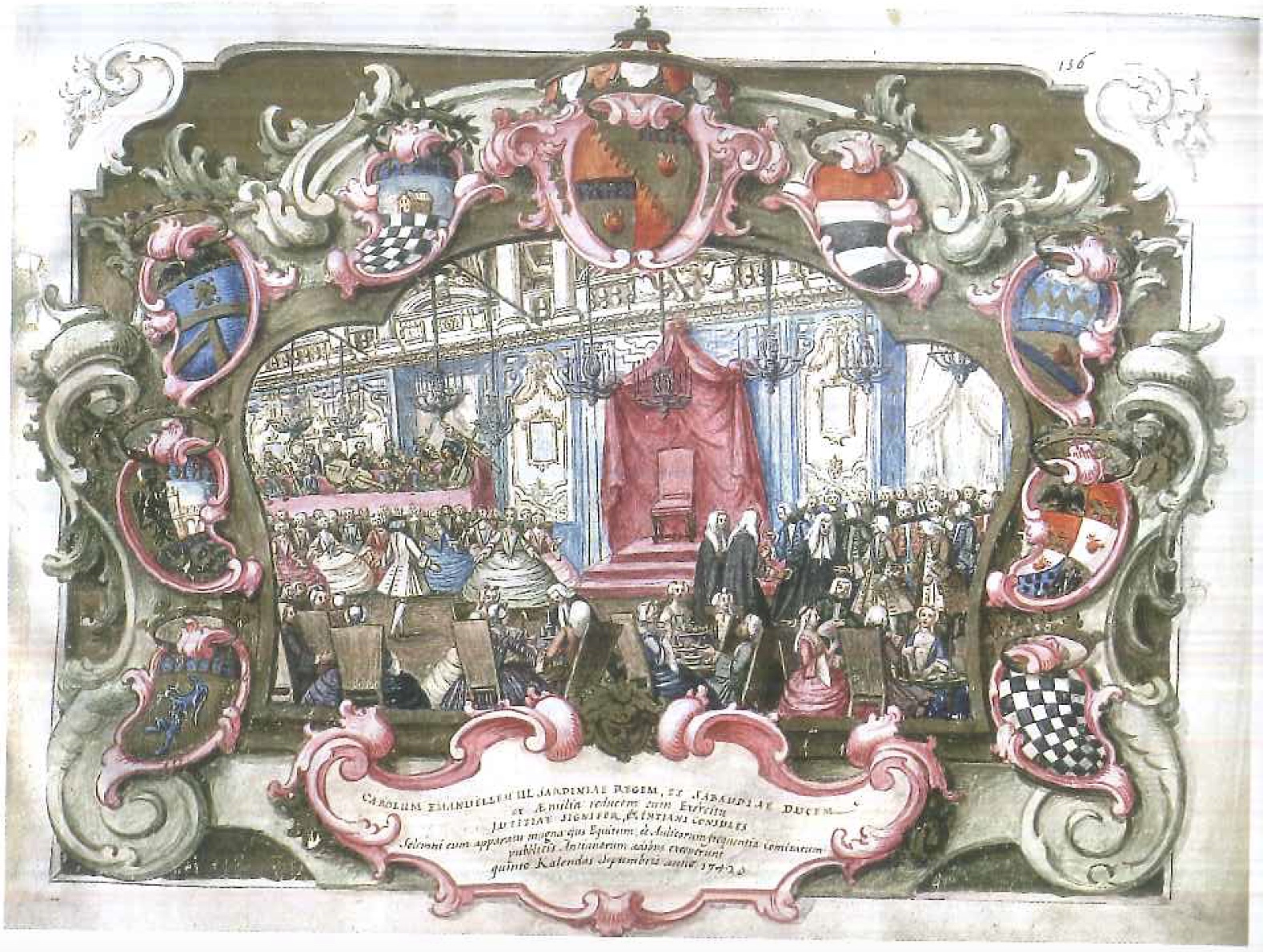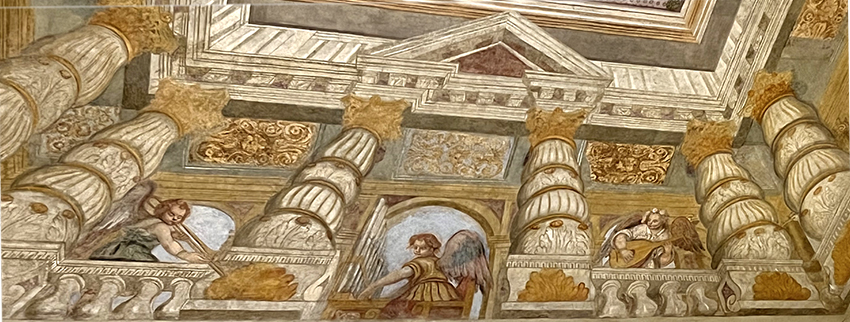A history of the trombone in timeline form. For sources see Trombone History Bibliography.
_______________
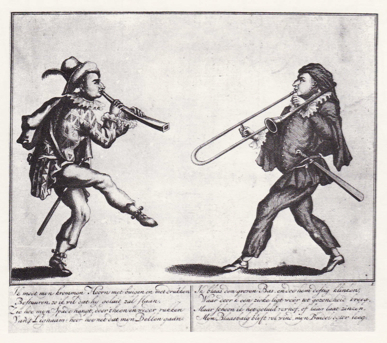 1700s—The Netherlands: An anonymous eighteenth-century Dutch etching features trombone and cornetto, seemingly dancing as they perform. The text reads, “I have to bend down, holding my instrument of pipes, so as to direct it so it will give a sound. Look how my club hangs from my body, as a result of my movements. Hear my bells ring. I blow the zink and make it sound distinguished. With it I can easily cure the sick. Though I can lower and raise the sound, my lungs remain full of air, and my pocket remains empty” (see above image; public domain) (Naylor 713).
1700s—The Netherlands: An anonymous eighteenth-century Dutch etching features trombone and cornetto, seemingly dancing as they perform. The text reads, “I have to bend down, holding my instrument of pipes, so as to direct it so it will give a sound. Look how my club hangs from my body, as a result of my movements. Hear my bells ring. I blow the zink and make it sound distinguished. With it I can easily cure the sick. Though I can lower and raise the sound, my lungs remain full of air, and my pocket remains empty” (see above image; public domain) (Naylor 713).
1700s—King David Playing the Harp, a painting from the German school, includes an angel holding a trombone (see below image; public domain).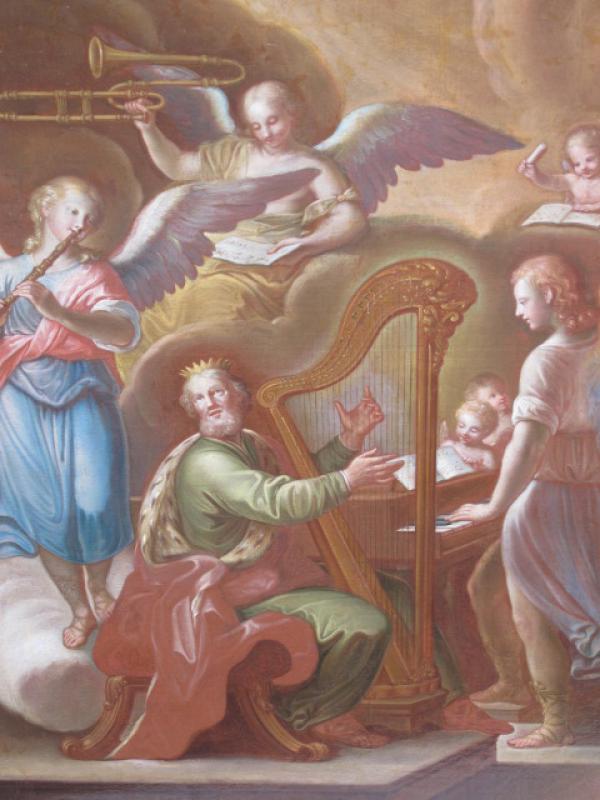
1700s—Novara Diocese, Piedmont Region: A Lombard-Piedmontese painter depicts an angel-trombonist (see below image; public domain) (source: chiesacattolica.it).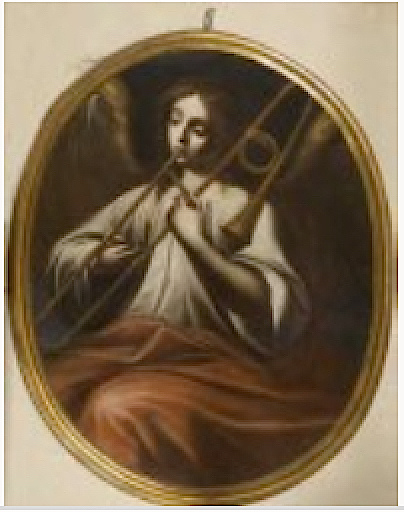
1701—Leipzig, Germany: St. Thomas’s church and St. Nicholas’s church both own 3 trombones (Terry 19).
1701—Germany: Johann Beer’s novel, Bellum musicum (Musical war) includes an illustration of a musical soldier made up of numerous instruments: cornetto, drum, violin, lute, and trombone (see below image; public domain).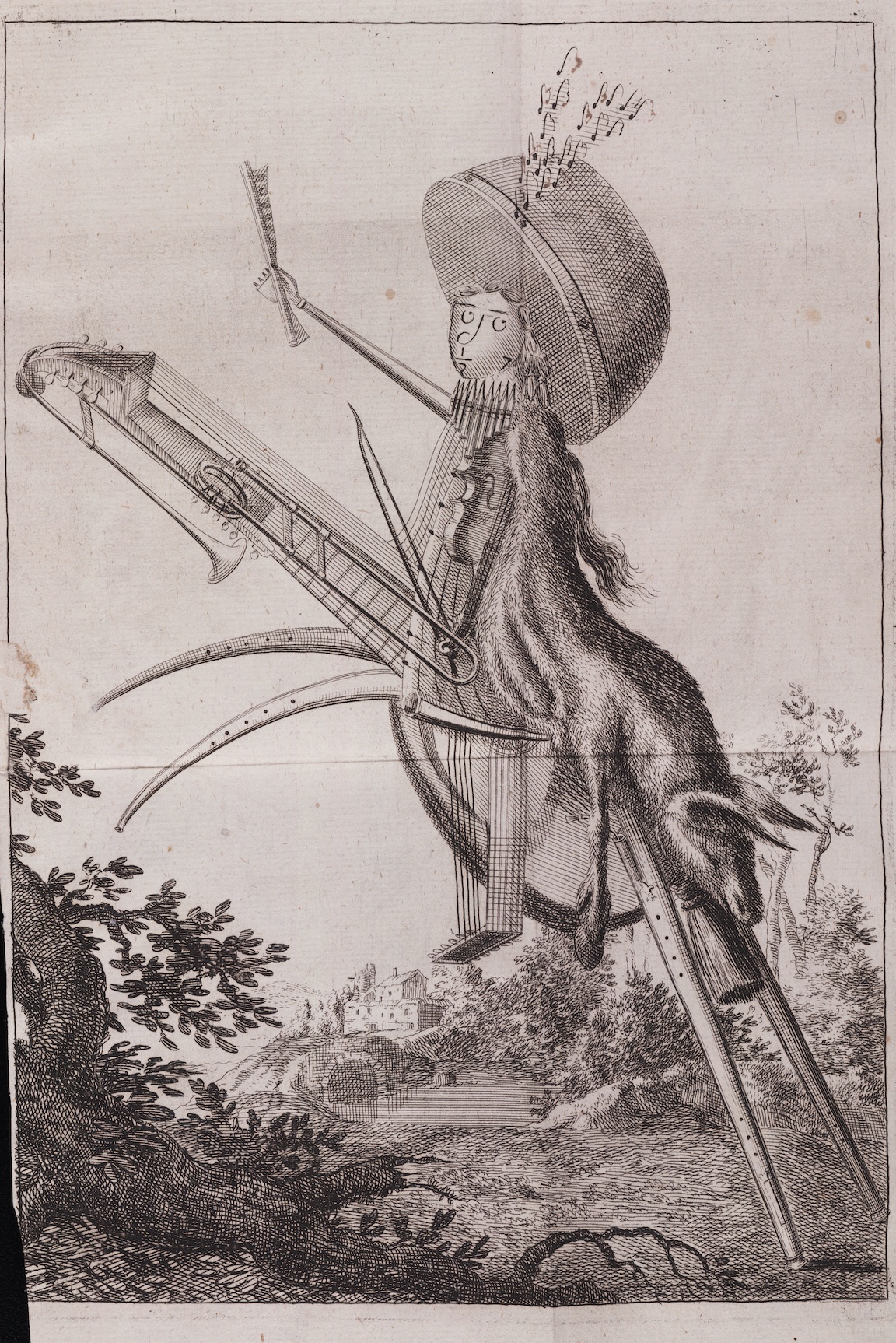
1701—Salzburg, Austria: Heinrich Biber uses trombones to double voices in his Missa St. Henrici (Cameron 81).
1701—Lauffen am Neckar, Germany: The organ housing at the evangelische Kirche St. Regiswindis includes 2 sculptures of angel-trombonists, the angels apparently playing one-handed (see below detail; public domain) (Völkl 50).
1701-06—Venice, Italy: 4 trombones are retained on regular payroll at St. Mark’s (Selfridge-Field, Caldara 119).
1701-1708—Bologna, Italy: 6-7 trombones are utilized for special festivals at San Petronio (Enrico, The Orchestra 35).
1702—Vienna, Austria: Hans Georg Christian is hired as a trombonist at the Imperial Court, a position he holds until his death in 1721 (Wigness 41; Selfridge-Field, Caldara 147).
1702-11—Vienna, Austria: The Hofkapelle orchestra retains 5 trombones on its regular payroll except for one year (1708), when it temporarily drops to 4 (Selfridge-Field, Caldara 124).
1703—Freiberg, Germany: The frontispiece of Johann Samuel Beyer’s singing manual, Anweisung für Singeskunst, features a decorative cluster of instruments that includes a trombone (see bottom-right of below image; public domain) (special thanks to Maximilien Brisson).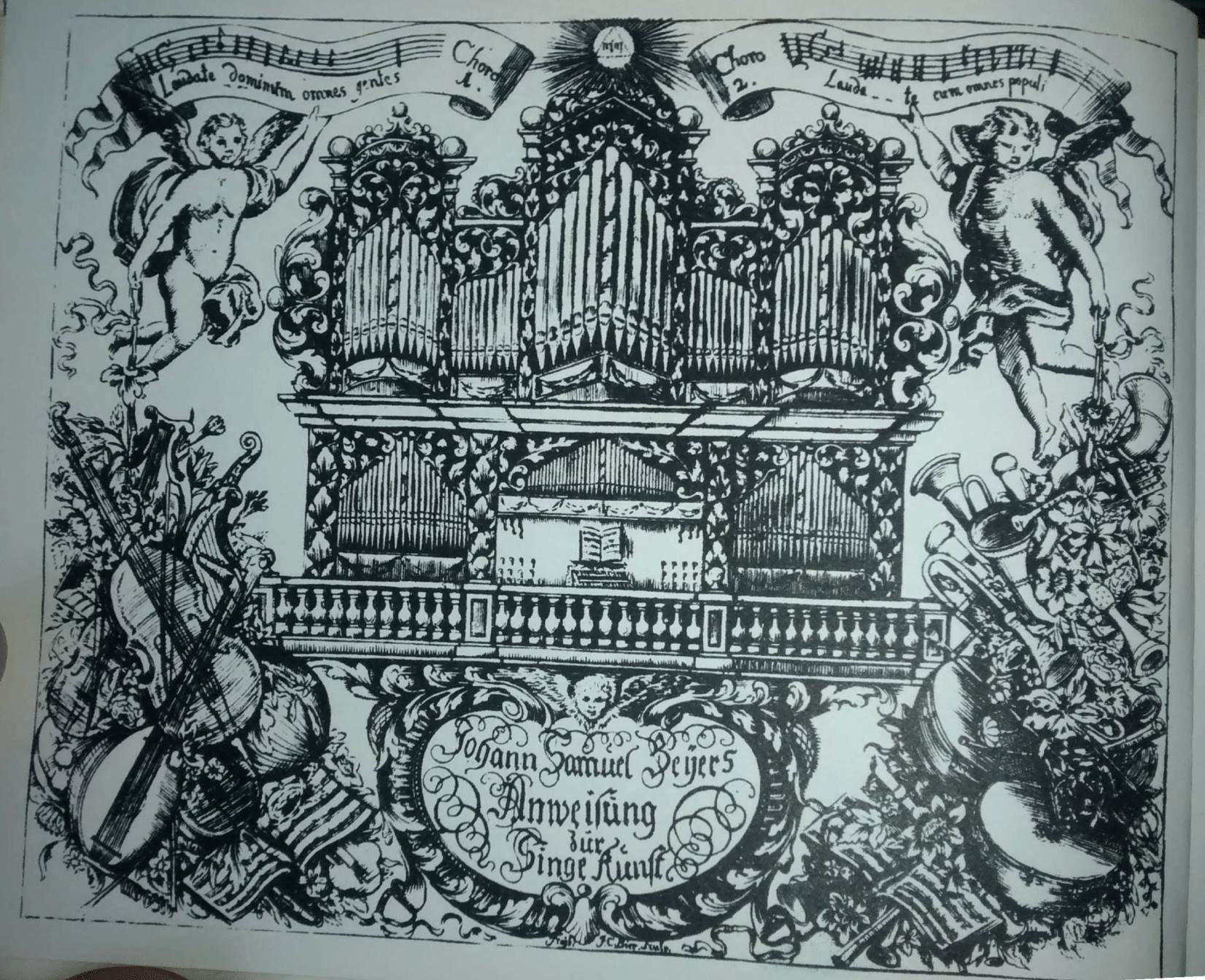
1703—Paris, France: Sébastien de Brossard describes four different sizes of trombones under the “trombone” heading of his Dictionnaire de musique: “There are several sizes which are capable of serving in the performance of different parts in the music: There is a small one which the Italians call TROMBONE PICCOLO and the Germans KLEINE ALT-POSAUNE which can serve as the counter-tenor; the part for it is usually entitled TROMBONE PRIMO or 1o. There is another one, a little larger, which is called TROMBONE MAGGIORE or MAJORE which can serve as the tenor; its part is entitled TROMBONE SECONDO, IIo, or 2o. There is a third, even larger, which the Italians call TROMBONE GROSSO and the Germans GROSSE QUART-POSAUNE which can supplement our viola or oboe; its part is entitled TROMBONE TERZO, IIIo, or 3o. Finally, there is one which is the largest of all, one which the Italians call TROMBONE GRANDE and which is heard a great deal especially playing the bass; its part is entitled TROMBONE QUARTO, IVo, or simply TROMBONE without other addition. It is usually given the fourth-line F-clef, but also very often the fifth-line F-clef because of the depth and profundity of its notes” (paragraph breaks not shown) (Brossard-Gruber 196).
1704—Tönning, Germany: A painted ceiling by Barthold Conrath at the Church of St. Lawrence depicts a group of angels playing wind instruments and percussion, including a jubilant angel-trombonist (see below image; public domain) (Bowles, The Timpani 167).
1704—Leipzig, Germany: Bach’s predecessor, Johann Kuhnau, complains to authorities that the church’s trombones are in a battered and useless condition. He requests a new “choir” of 4 trombones—discant, alto, tenor, and bass—but does not receive it (Terry 18).
1704—Vienna, Austria: Marc’ Antonio Ziani’s aria, “Quel sembiante” from Il mistico Giobbe, features solo soprano voice with trombone obbligato (Carter, Trombone Obbligatos).
1704—Vienna, Austria: Johann Joseph Fux’s Te Deum, K 271, calls for 2 trombones.
1704-14—Saalfeld, Germany: Carlo Ludovico Castelli paints a putto playing trombone in Saalfeld’s Schlosskapelle (see below image; public domain).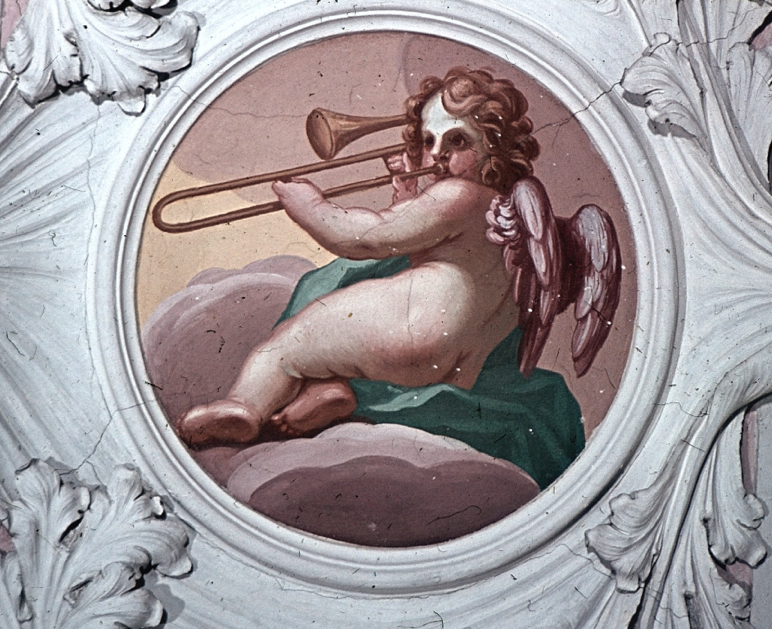
c. 1705—Irsee, Germany (near Kaufbeuren): A fresco by Magnus Remy (1674-1734) decorating the ceiling of Irsee Abbey features angels playing various brass instruments, including what appears to be a trombone (see below image; public domain).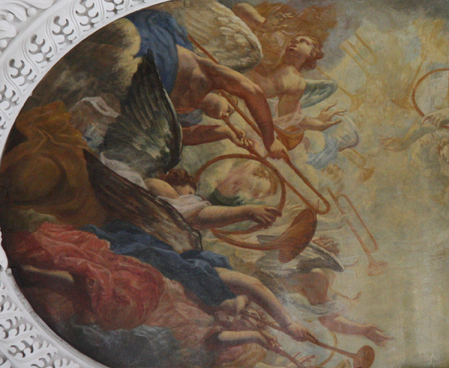
1705—Vienna, Austria: “Alme ingrate,” an aria from an anonymous, untitled sepolcro, features solo soprano voice with trombone obbligato (Carter, Trombone Obbligatos).
1705—Rome, Italy: The pope’s wind band, called “Concerto Capitolino,” consists of 6 trombones and 2 cornetts. They perform for papal and civic ceremonies, as well as for meals of the Sig. Conservatori (Whitwell, Baroque 65).
1705—Vienna, Austria: Marc’ Antonio Ziani writes the solo motet Alma Redemptoris Mater. Scored for 2 trombones, bassoon, alto voice, and continuo, it includes numerous solo passages for trombone (Wigness 26).
1705—Lübeck, Germany: Buxtehude calls for muted trombone in his Castrum doloris: “trombones and trumpets with mutes, and all other instruments similarly muted” (Schulze, Johann Sebastian Bach’s Orchestra).
1706—Hamburg, Germany: Friedrich Erhard Niedt, in his Musicalischer Handleitung, says, “The trombone is an instrument that is little known except perhaps to Kunstpfeifer…and many, who wish to try something with trombones because they sound so magnificent, do not know what is proper on it” (Guion, Trombone 28).
1706—Austria: The typical infantry band includes trombone (Whitwell, Baroque 116).
1706—Bologna, Italy: At the Palazzo Albergati, 87 instrumentalists perform a serenata; among the players are 4 trombones, divided into pairs on either side of the harpsichord. Many of the musicians are members of the Accademia de’Filarmonici (Crowther, The Oratorio in Bologna 18).
1706—Vienna, Austria: Marc’ Antonio Ziani’s La morte vinta sul includes 3 arias that feature trombone as an obbligato instrument (Carter, Trombone Obbligatos).
1707—Vienna, Austria: Marc’ Antonio Ziani’s aria, “Non é giunta” from Il Sacrifizio d’Isacco, features solo tenor voice with trombone obbligato (Carter, Trombone Obbligatos). The voice in the below recording is soprano rather than alto.
1707—An engraving by Romeyn de Hooghe for a collection of psalms features a decorative cluster of instruments that includes a trombone (see detail below; public domain) (special thanks to Bruce Dickey).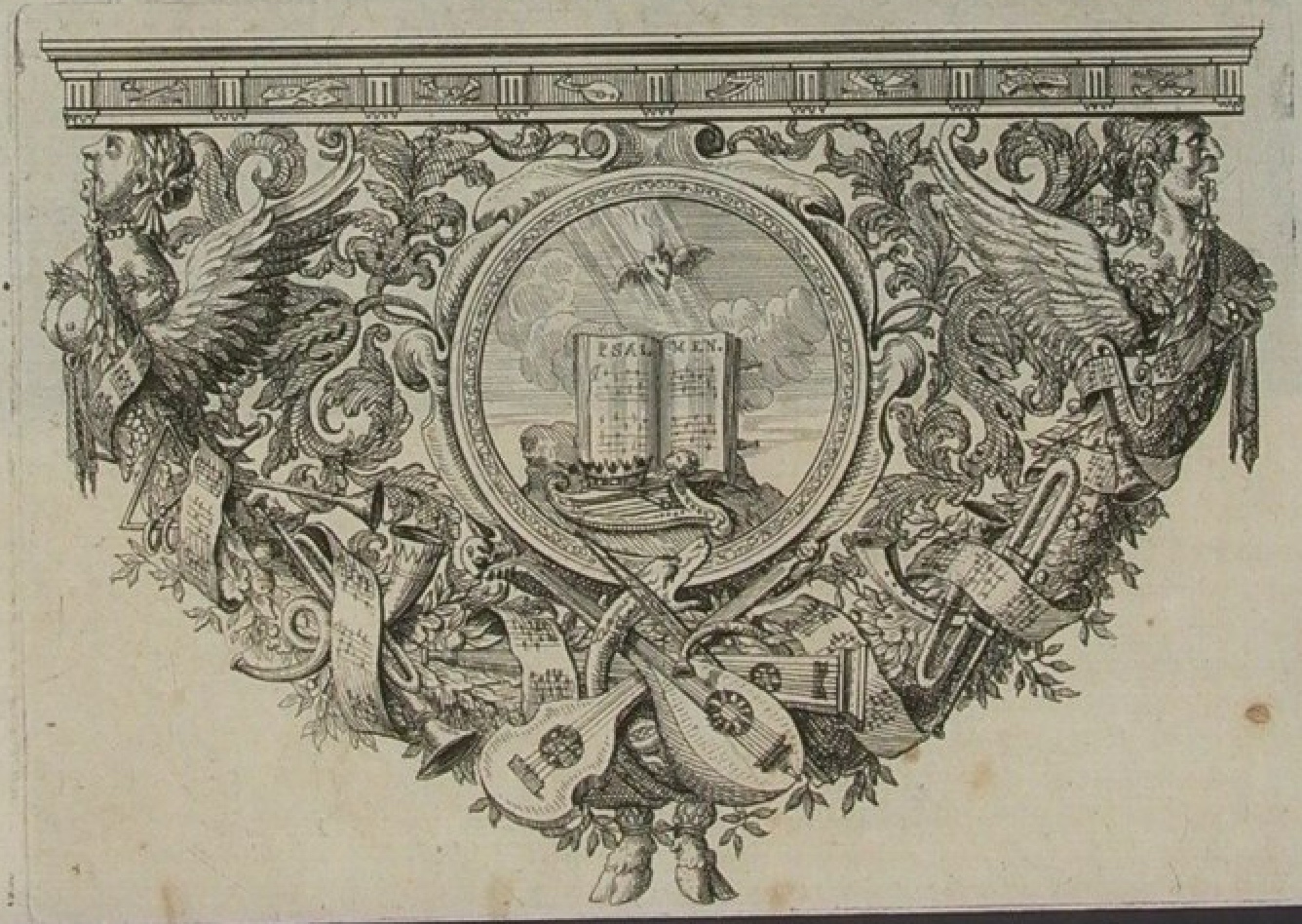
1707-08—Venice, Italy: The orchestra at St. Mark’s retains 3 trombonists on its payroll (Selfridge-Field, Caldara 119).
1708—Rome, Italy: Musicians are among those responsible for paying a special tax, sometimes called the “1708 Grand Taxation,” to raise funds to fight the imperial army, which is threatening Rome. The tax is divided by the Congregazione di Santa Cecilia among 5 categories of professional musicians: singers, maestri di cappella, organists, music copyists, and instrumentalists. Of the woodwind and brass instrumentalists listed, trombones are by far the most numerous: trombone (13), cornet (2), flute (2), trumpet (1), oboe (1), horn (1). All musicians who list trombone as their instrument also list at least one other instrument, violin being the most common: violin (9), cello (4), double bass (3), violone (1), lute (1), horn (1), trumpet (1). The best-paid on the list of instrumentalists are Antonio Montanari (violin) and Matteo Fornari (trombone and violin). Fornari, who is labeled as guardino (in charge) of the whole group of instrumentalists. is a trombonist for the Capitol (Rome city hall) and a personal friend of Arcangelo Corelli (Barbieri, An Assessment of Musicians).
1708—Rome, Italy: On Easter Sunday and Monday, Arcangelo Corelli conducts Handel’s oratorio, La Resurrezione, at the Palazzo Bonelli. The orchestra, which consists of about 45 players, includes a trombonist identified as “Andrea” in the orchestra; trombone is presumably used as a continuo instrument in this case (Guion, Short History).
1708—Barcelona, Spain: At the marriage of Archduke Charles VI of Austria to Princess Elizabeth of Brunswick-Wolfenbüttel, celebrated in Barcelona, “A Te Deum laudamus, composed by J[ohann] J[oseph] Fux, was sung ‘with the sweetest harmonies’ for two sopranos, alto, tenor, bass and an instrumental ensemble consisting of two violins, three violas, two trumpets, two trombones and timpani” (Bowles, Timpani 415).
1708—Vienna, Austria: Marc’ Antonio Ziani’s aria, “Se dei pur senz’ aita” from La passione nell’orto, features an obbligato alto trombone and is scored for alto voice and alto trombone (Carter, Trombone Obbligatos).
1709—Vienna, Austria: Silvano Angelo Fontana is appointed as trombonist at the Imperial Court, a position he holds until 1711 (Wigness 41; Selfridge-Field, Caldara 148).
1709—Leipzig, Germany: Johann Kuhnau, Bach’s predecessor, reports that the Stadtpfeifer, Kunstgeiger, and apprentices supply him with 2 trumpeters, 2 oboists or cornettists, 3 trombonists, and 1 bassoonist (Terry 17).
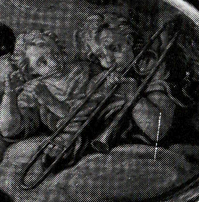
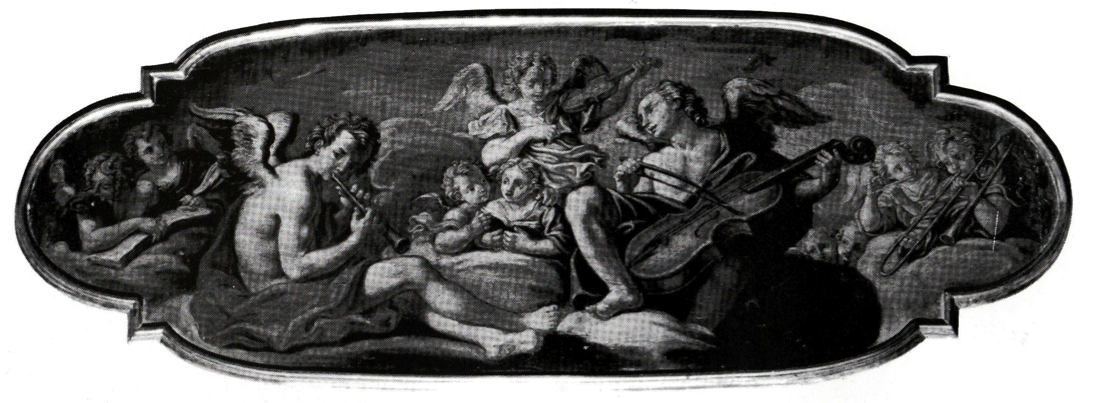 1709—Monticelli d’Ongina, Italy: The church Collegiata di San Lorenzo is refurbished in Baroque style. Probably at this time an anonymous artist paints a fresco in the church depicting several angel-musicians, including a trombonist. This painting, along with a painted wood ceiling in Tönning, Germany (see 1704, above), is a relatively late example of trombone being depicted among angel-musicians (see facing detail and full image, below; public domain) (Genesi).
1709—Monticelli d’Ongina, Italy: The church Collegiata di San Lorenzo is refurbished in Baroque style. Probably at this time an anonymous artist paints a fresco in the church depicting several angel-musicians, including a trombonist. This painting, along with a painted wood ceiling in Tönning, Germany (see 1704, above), is a relatively late example of trombone being depicted among angel-musicians (see facing detail and full image, below; public domain) (Genesi).
1709-32—Venice, Italy: The orchestra at St. Mark’s retains a single trombonist on its payroll (Selfridge-Field, Caldara 119; Guion, Trombone 161).
c. 1710—Stuttgart, Germany: Johann Georg Christian Störl writes 6 sonatas for cornett and 3 trombones (Collver 70).
c. 1710—England: Roger North, describing acoustical properties of musical instruments, says the following about trombone: “The other instruments that sound ‘by the spring of the lipps’ are the ‘tuba ductilis or Sackbutt…used in consorts of wind musick’” (Wilson, Roger North 229).
1710—Italy: Francesco Magini writes 2 sonatas for the combination of 4 trombones and 2 cornetts (Collver 59).
1710—Verona, Italy: Felice Torelli, younger brother of composer Giuseppe Torelli, depicts an angel playing trombone in Immacolata Concezione, painted for the church of Sant’Orsola dei Mendicanti shortly after the proclamation of the feast day of the Immaculate Conception. The image is noteworthy because no other musical instruments are depicted with the trombone. The artist includes the usual flat stays found on trombones of the time, but the slide appears to be somewhat longer than usual and the player’s grip on the instrument’s back tubing somewhat unorthodox (see below image; public domain; Verona, Museo di Castelvecchio) (Chiodini; Oxford Art Online).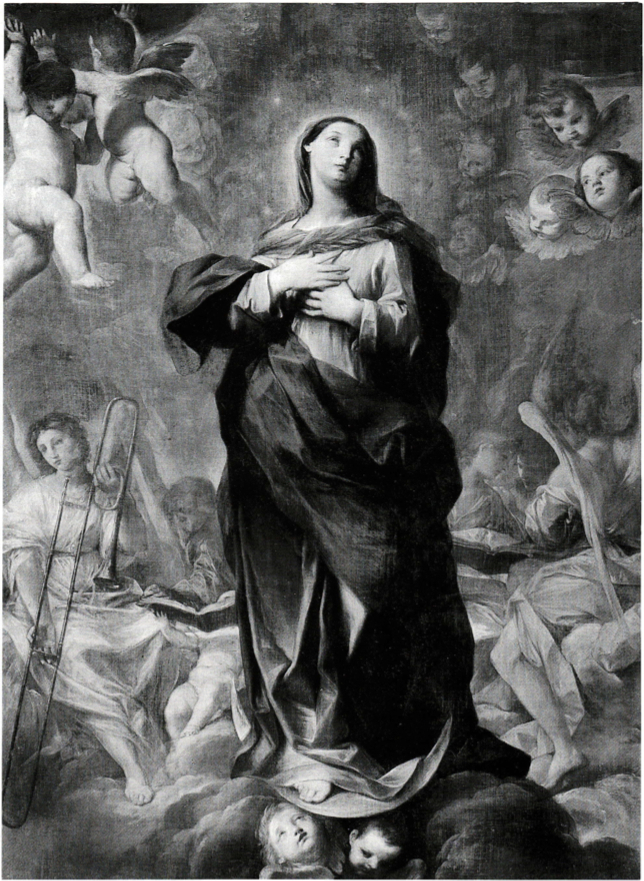
Early 1710s—Merseburg, Germany: Johann Joachim Quantz, later known as a flautist and composer, is apprenticed to the Merseburg civic musicians, learning trombone, violin, oboe, trumpet, cornett, horn, recorder, bassoon, German bass violin, cello, and viola da gamba, “all of which a proper town piper must be able to play,” according to Quantz’s autobiography (F.W. Marpurg, Historisch-kritische Beyträge, vol. I, p. 199, as quoted in Rose, The Musician in Literature 77).
1711—Vienna, Austria: trombonist Leopold Christian Jr. begins employment at the Imperial Court, where he holds a position until his death in 1760. Fux regards him very highly, stating, “Leopold Christian, the younger trombonist, repeats his thrice request for an increase of his pay of 570 guldens. Because this applicant is such a virtuoso, and because his equal could not be found in the past and probably not in the future, it is my opinion that this applicant would like to receive an increase to 40 thallers monthly, with which he will be satisfied” (Wigness 28; Selfridge-Field, Caldara 147). His salary is higher than any other eighteenth-century Viennese court trombonists. Many of the important trombone solos from this time (e.g., Wagenseil’s Concerto, Fux’s Sonata a Quattro) may have been inspired by him (Wigness 41).
1712-24—Vienna, Austria: The Hofkapelle orchestra retains 3 trombones on its regular payroll except for 2 years (1718-19), when it raises to 4 (Selfridge-Field, Caldara 124).
1713—Hamburg, Germany: Johann Mattheson writes, “The most magnificent-sounding trombone…is a type of trumpet, on which the notes are produced by pulling out and in, in conjunction with blowing. There are large and small trombones, namely: small alto, large alto, tenor or large quart, and bass trombone, which can form a full choir by themselves, but are used very rarely, except in church pieces and solemn music” (Guion, Trombone 25).
1713—Francesco Magini publishes a collection of sonatas titled Sonate di Francesco Magini per il Campidoglio 1713. It includes 7 different sonatas scored for 4 trombones (alto, tenor, tenor, bass) and 2 cornetts (Collver 59).
1714—Venice, Italy: The wind players on staff at St. Mark’s include 2 trombones, 1 cornetto, 1 oboe, and 3 piffari (probably trumpets). Antonio Biffi, the maestro di capella, wants to expand the orchestra. He notes that “because it is impossible to find more players of bassoon, trombones and theorboes, they [the Procurators] will allow the substitution of suitable stringed or wind incstruments…” (Arnold, Orchestras in Eighteenth-Century Venice). When the last trombonist, Lodovicio Vazzio, dies in 1732, his place is filled by a trumpeter (Guion, Trombone 161).
1714—Lüneburg, Germany: A major rebuild of the organ in Johanniskirche is completed by Matthias Dropa. One of several rebuilds and renovations after the organ’s original installation in 1551-53, it is probably this early 18th-century rebuild that adds the sculptures of what appear to be 2 angel-trombonists perched atop the organ pipes (see detail of one of the trombones below; public domain).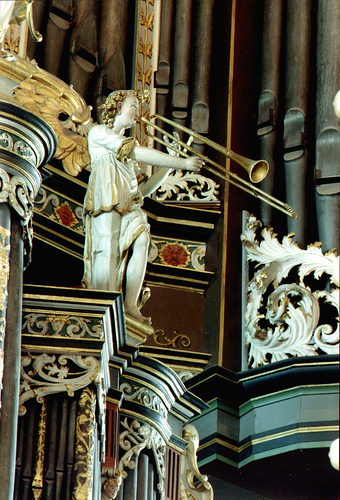
c. 1715—Vienna, Austria: A fresco above the organ loft in Vienna’s Peterskirche (St. Peter’s church) depicts cherubs playing trombone and bassoon (see below image; public domain).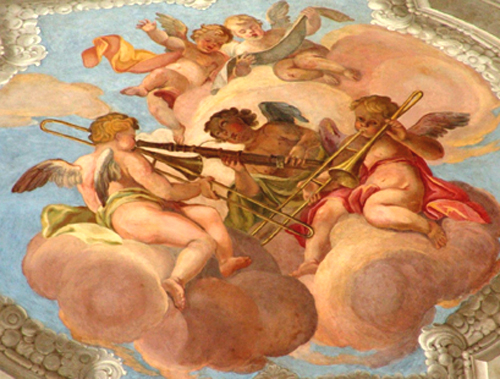
1715—Vienna, Austria: Johann Joseph Fux calls for 3 trombones in his Orfeo ed Euridice (Spitzer Table 1.1).
c. 1716—Johann Joseph Fux calls for trombone, violin, cornetto, and bassoon in his Sonata a 4, K. 347 (Collver 50).
1716—Vienna, Austria: Johann Joseph Fux’s aria, “Vedi che il Redentor” from Il fonte della salute, features soprano voice and obbligato alto trombone (Carter, Trombone Obbligatos).
1716-1727—Germany: Protestant minister Daniel Pfisterer keeps a personal sketchbook in which he sketches various aspects of his surroundings. Included is a drawing depicting numerous instruments on and around a table. The trombone is on the right (see below image; public domain) (source: Recorder Home Page).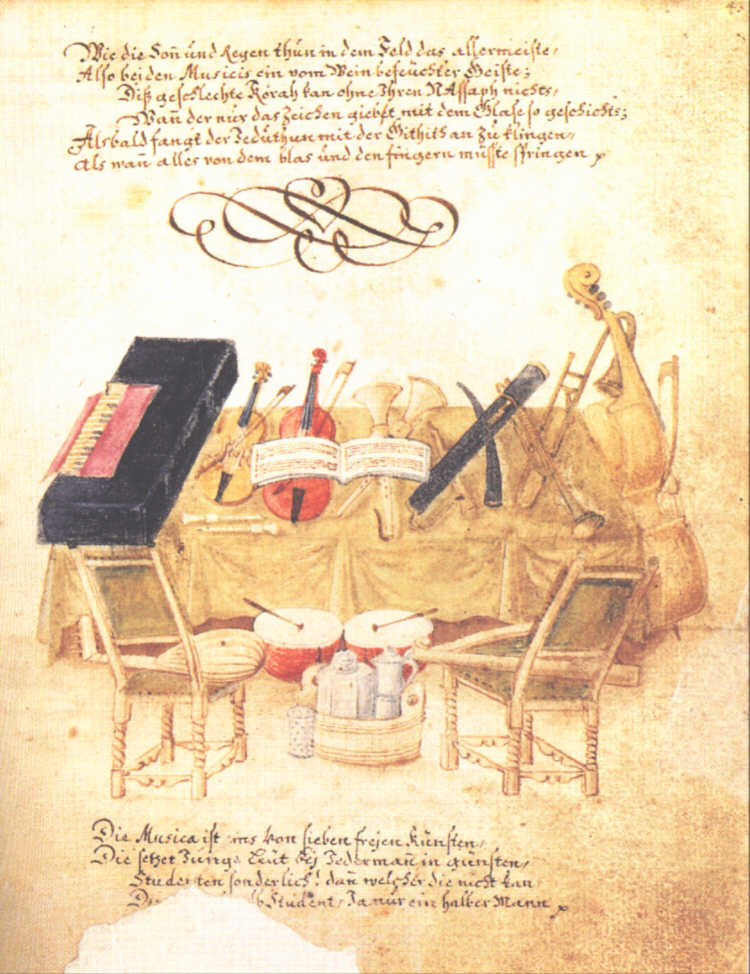
1717—Vienna, Austria: Antonio Caldara’s aria, “Quell’amor” from Santa Ferma, features soprano voice and obbligato alto trombone (Carter, Trombone Obbligatos).
1717—Dresden, Germany: the court ensemble includes 8 trombonists (Spagnoli 93).
1717—Sorau, Poland: Georg Philipp Telemann calls for 3 trombones in his Erhöre mich, wenn ich rufe (Collver 178).
c. 1718—Vienna, Austria: Johann Joseph Fux, a leading composer at the Imperial Court, writes Sonata a Quattro. Scored for violin, cornetto, trombone, bassoon, and organ, it is an early example of the virtuosic use of trombone in a chamber music setting (Wigness 14).
1718—Vienna, Austria: Johann Joseph Fux’s aria, “Dal limbo” from Cristo nell’orto, features obbligato alto trombone and is scored for alto voice, alto trombone, and 2 violins (Carter, Trombone Obbligatos).
1718—Vienna, Austria: Francesco Conti’s aria, “Mia compagna io la credea” from La colpa originale, features alto voice with alto trombone obbligato (Carter, Trombone Obbligatos).
1718—Württemberg, Germany: in an inventory of the court’s instruments, 3 posaunen are included among a list of “instruments which partly need to be repaired and partly could be used if necessary” (Owens 240).
1719—Sorau, Poland: Georg Philipp Telemann calls for 3 trombones in his Jesu, wirst du bald erscheinen (Collver 178).
1719—Vienna, Austria: Johann Joseph Fux’s aria, “Da Christo ch’é pio” from Gesu Cristo negato da Pietro, features alto voice with alto trombone obbligato (Carter, Trombone Obbligatos).
c. 1720—Nuremberg, Germany: Johann Christoph Weigel depicts a trombonist in an engraving in Musicalishes Theatrum. The caption below the engraving reads, “Posaune: I am searching for glory in every place, In antiquity, as well as in effect, One can see what I can do in both Testaments, I destroyed walls when spoken to in a proper manner, No offering or feast could be properly conducted without me, And nowadays I adorn a large instrumental choir” (Weigel pl. 6; translation from Naylor 197) (see below image; public domain). In addition, the front cover of the collection of plates, which includes many musical instruments, depicts the slide of a trombone hanging on a wall (Weigel pl. 1).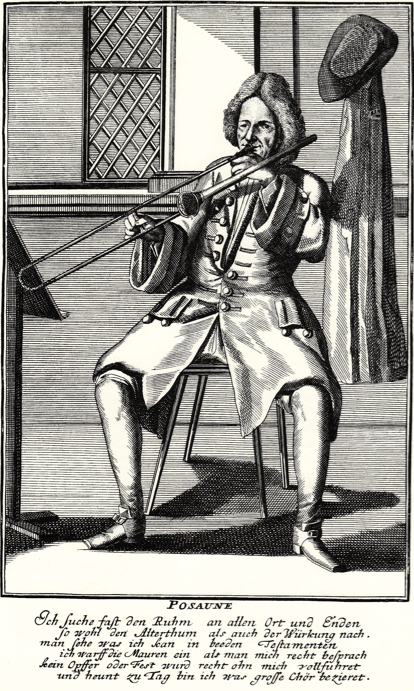
c. 1720—Vienna, Austria: Antonio Caldara uses trombones to double strings in his Mass for 4 Voices (Cameron 84).
c. 1720—Augsburg, Germany: An engraving by Martin Engelbrecht titled Trompeten, Paucken, Posaunen depicts men playing trumpet and kettledrums, with trombone on nearby table. The text below the picture says, “Here one demonstrates music for devotion, pleasure and dancing for various types of musical instruments…Music about men and horses can only be satisfied by fighting. Trumpets, timpani, muskets, Barthaune! They make the right sound together. On the other hand, zinken and trombones [posaunen] are needed always in peacetime, as well as in sorrow and times of joy whenever music is well presented” (see below image; public domain) (Naylor 100, 197).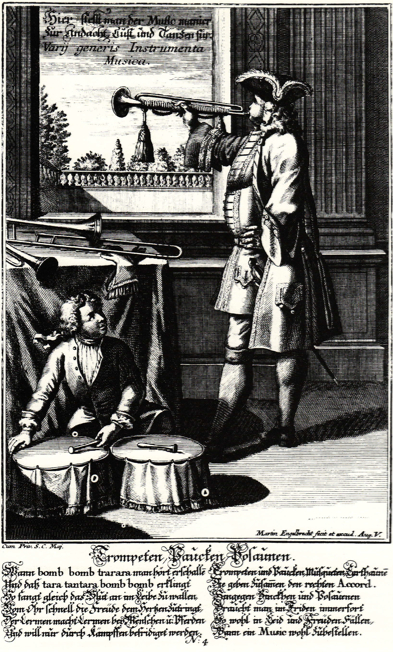
c. 1720—Augsburg, Germany: Christoph Augengicht, Trombonist, a watercolored engraving that is part of a series of musical caricatures by J.A. Müller, shows a trombone with a slide that extends past the bell, but a back bow of tubing that does not quite reach behind the shoulder. The player uses an extension handle on the slide (see below image; public domain) (German National Museum, Nuremberg).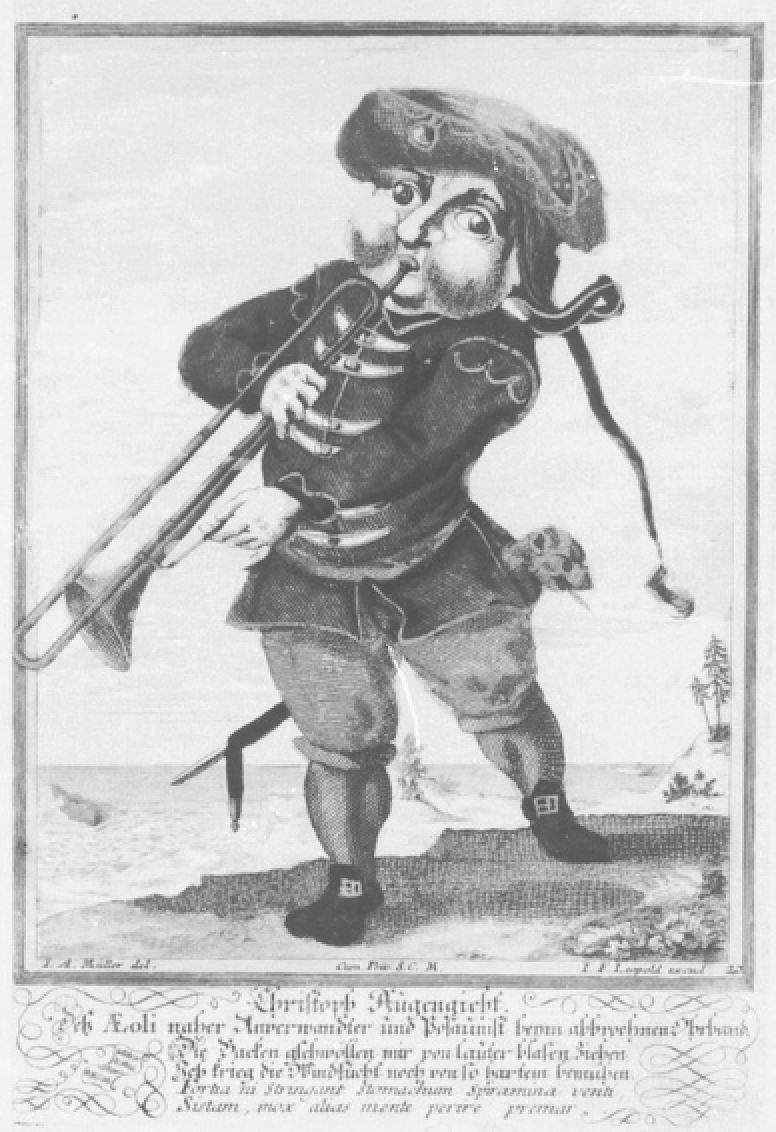
1720—Vienna, Austria: Trombonist Andreas Boog is hired at the Imperial Court. He holds the position until his death in 1763 (Wigness 41; Selfridge-Field, Caldara 147).
1720—Vienna, Austria: Johann Joseph Fux, Kapellmeister at the Imperial Court, writes the Emperor’s Requiem for the funeral of the widow of Emperor Leopold I. The work, which reportedly continues to be used at royal funeral services up until 1743, utilizes 2 trombones to double the lower vocal lines and for an obbligato role in the “Tuba Mirum.” The obligato use of trombone in the “Tuba Mirum,” of course, foreshadows Mozart’s Requiem (Chase 153). (The “Tuba Mirum” in the YouTube clip below begins at :43.)
1720—Vienna, Austria: Johann Joseph Fux’s aria, “O beata l’alme” from La cena del Signore, features soprano and alto voice with alto trombone obbligato (Carter, Trombone Obbligatos).
c. 1721—Vienna, Austria: Antonio Caldara uses alto trombone in a virtuosic obbligato style to accompany alto and tenor vocal soloists in Jesu dulcis memoria (Selfridge-Field, Caldara 130).
1721—Vienna, Austria: The Imperial Court maintains 4 full-time trombonists (Wigness 3).
1721—Vienna, Austria: Andreas Steinbruckner is appointed as a trombonist at the Imperial Court, a position he holds until his death in 1724 (Wigness 41-42; Selfridge-Field, Caldara 150).
1721—Vienna, Austria: Giuseppe Porsile’s aria, “Caro trono” from Il zelo di Nathan, features alto voice with alto trombone obbligato (Carter, Trombone Obbligatos).
1721—Hamburg, Germany: Telemann calls for 3 trombones in his Sehet an die Exempel der Alten (Collver 178).
1721—Hamburg, Germany: Friedrich Erhard Niedt’s Musicalischer Handleitung (The Musical Guide) discusses trombone, including mention of alto, tenor, and bass trombones. In the second edition, edited by Johann Mattheson, Mattheson appends the following: “Because the trombone is an instrument which is known to few, except for trained wind players, I would like all the more to present its precise compass, especially since, in the First Edition, it was dreadfully skipped over, and since many composers, who would like to write music for trombones, because they sound so splendid, do not know how to write for them (Niedt 151-152).
1722—Vienna, Austria: Antonio Caldara’s aria, “Quando amato” from Il Ré del dolore, features tenor voice with alto trombone obbligato (Carter, Trombone Obbligatos; Selfridge-Field, Caldara 138).
1723—Leipzig, Germany: J. S. Bach’s Cantata No. 21 utilizes 4 trombones to double vocal lines.
1723—Leipzig, Germany: Bach’s Cantata No. 23 utilizes 3 trombones to double vocal lines (mvt 4).
1723—Leipzig, Germany: J. S. Bach’s Cantata No. 25 utilizes trombones in an independent, non-doubling manner: 3 trombones and a cornett play an independent chorale (mvts 1, 6).
1723—Leipzig, Germany: J. S. Bach’s Cantata No. 64 utilizes 3 trombones to double vocal lines (mvts 1, 2, 4, 8).
https://www.youtube.com/watch?v=n_VPN65q0-o
1723—Vienna, Austria: Giuseppe Porsile’s aria, “La sovrana eterna” from Il trionfo di Giuditta, features alto voice with alto trombone obbligato (Carter, Trombone Obbligatos).
1723—Vienna, Austria: Francesco Conti’s aria, “Fuggo d’una in altra selva” from Il David perseguitato, features alto voice with alto trombone obbligato (Carter, Trombone Obbligatos).
1723—Rome, Italy: Filippo Bonanni publishes the complete version of his Gabinetto Armonico, which contains a number of illustrations of musical instruments. Among the engravings is a separate plate, titled Trombone Spezzata, of a man playing trombone (see below image; public domain) (Bonanni 5). The artist is Arnolt van Westerhout (Guion, Trombone 29).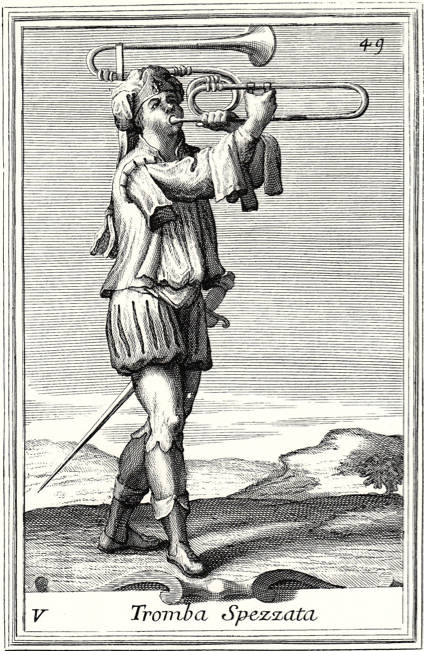
1723—Dresden, Germany: Bohemian musician Jan Dismas Zelenka, composer at the Dresden court, writes Responsoria pro hebdomada sancta, which includes colla parte trombones. An autograph remark at the head of the score indicates, “Tutte le Viole e Tromboni,” while colla parte instructions elsewhere include “[Alto clef] Alto Viola e Alto Trombone; [Tenor clef] Tenore Viola e Tenore Trombone; [Bass clef] Violoncello, Violone, Fagotto e Bass Trombone” (Stockigt, 117).
1724—Vienna, Austria: Antonio Caldara’s arias, “Deh scogliere” and “Languire, morire” from Morte, e sepoltura di Christo, feature obbligato alto trombone with solo voice (Carter, Trombone Obbligatos).
1724—Leipzig, Germany: J. S. Bach’s Cantata No. 2 utilizes 4 trombones to double vocal lines (mvts 1, 6).
1724—Leipzig, Germany: J. S. Bach’s Cantata No. 38 utilizes 4 trombones to double vocal lines (mvts 1, 6).
1724—Leipzig, Germany: J. S. Bach’s Cantata No. 96 utilizes one trombone to double vocal lines (mvt 1).
1724—Leipzig, Germany: J. S. Bach’s Cantata No. 101 utilizes 3 trombones to double vocal lines (mvts 1, 7).
1724—Leipzig, Germany: J. S. Bach’s Cantata No. 121 utilizes 3 trombones to double vocal lines (mvts 1, 6).
1724—Leipzig, Germany: J. S. Bach’s Cantata No. 135 utilizes trombone in an independent, non-doubling manner: a single trombone is called upon to play continuo lines (mvt 1).
c. 1725—Rome, Italy: French artist Etienne Parrocel (1696-1775), who has relocated to Italy, draws Trois anges musiciens, after a fresco by Guido Reni located in Rome’s San Gregorio Magno (for Reni, see 17th century timeline) (see below image; click image to expand; public domain) (Avignon Musée Calvet Inv. 996.7.31).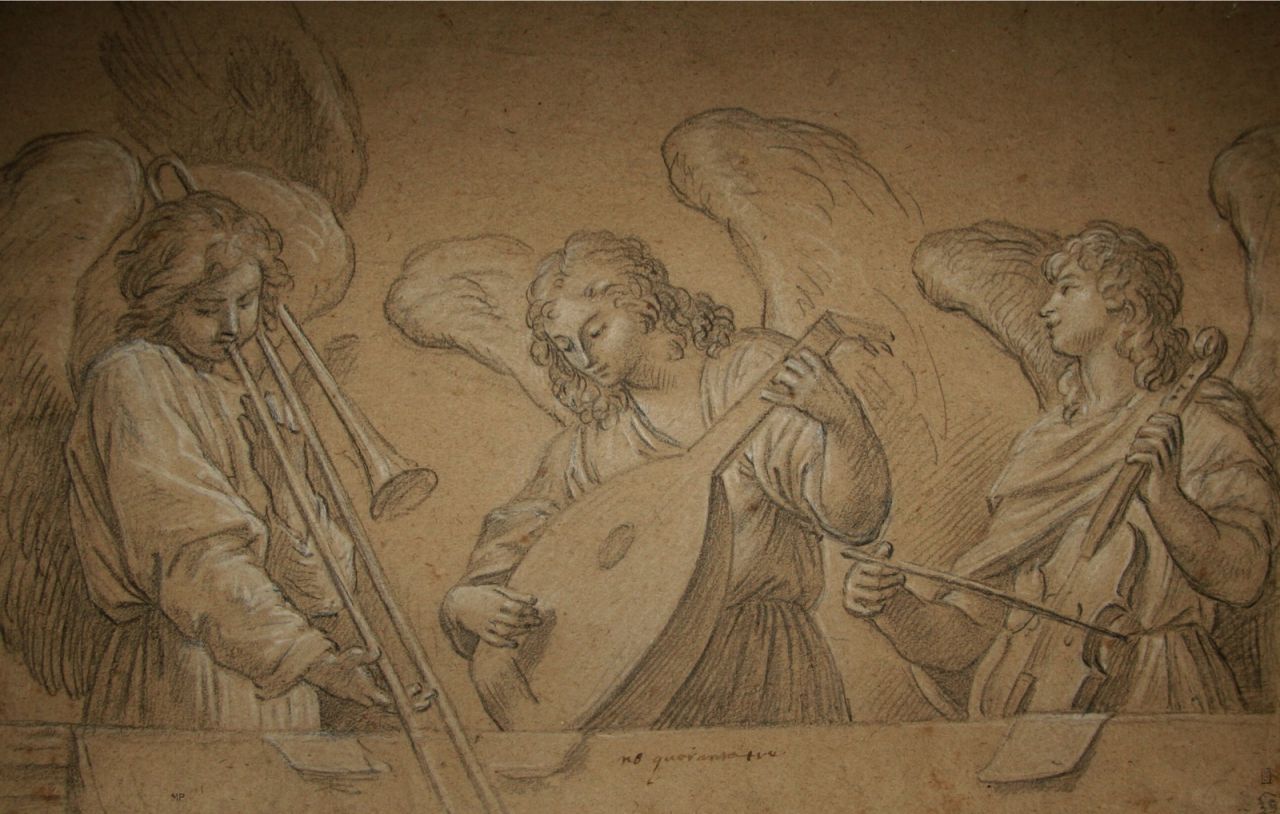
c. 1725—France: A still life of musical instruments, attributed to Jean-Baptiste Oudry (1686-1755), includes what is probably a disassembled trombone (see below image; public domain) (source: europeana.eu, National Library of France).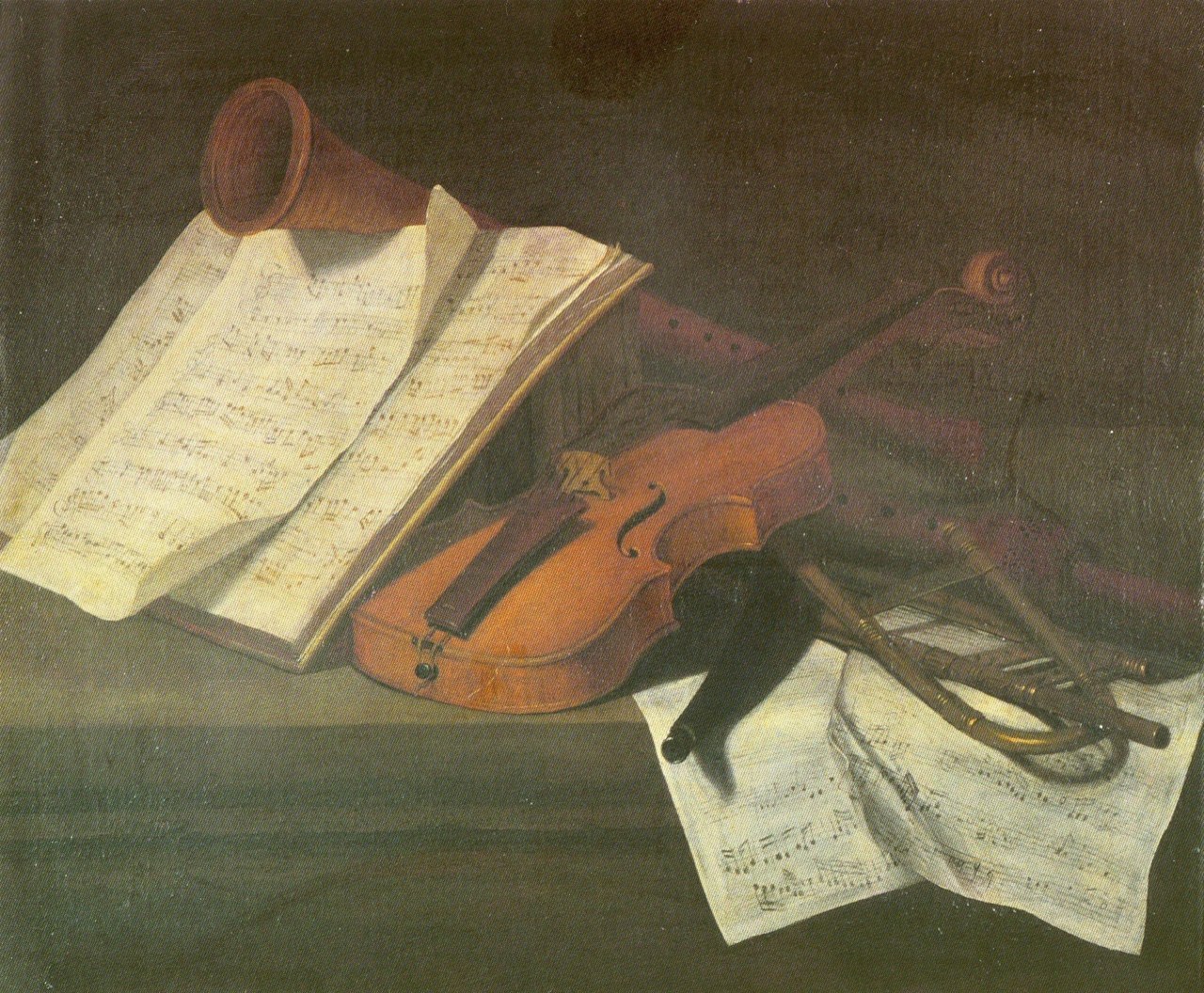
1725—Leipzig, Germany: J. S. Bach’s Cantata No. 3 utilizes one trombone to double vocal lines (mvt 1).
https://www.youtube.com/watch?v=bjPq0HQrUWg
1725—Leipzig, Germany: Bach’s Cantata No. 4 utilizes 3 trombones to double vocal lines (mvts 2, 3, 8).
1725—Leipzig, Germany: J. S. Bach’s Cantata No. 28 utilizes 3 trombones to double choral parts (mvts 2, 6).
1725—Leipzig, Germany: J. S. Bach’s Cantata No. 68 utilizes 3 trombones to double choral parts.
1725—Vienna, Austria: Antonio Caldara’s aria, “Qual del Libano” from Le profezie evangeliche di Isaia, features alto voice with alto trombone obbligato (Carter, Trombone Obbligatos).
1725—Vienna, Austria: Ignaz Steinbruckner is hired as trombonist at the Imperial Court, a position he holds until he is pensioned and released in 1762 (Wigness 42; Selfridge-Field, Caldara 150).
1725-30—Vienna, Austria: A fresco by Johann Michael Rottmayr in Karlskirche (St. Charles’s Church) includes a trombone-playing angel (see below image; public domain) (special thanks to Kellyn Haley).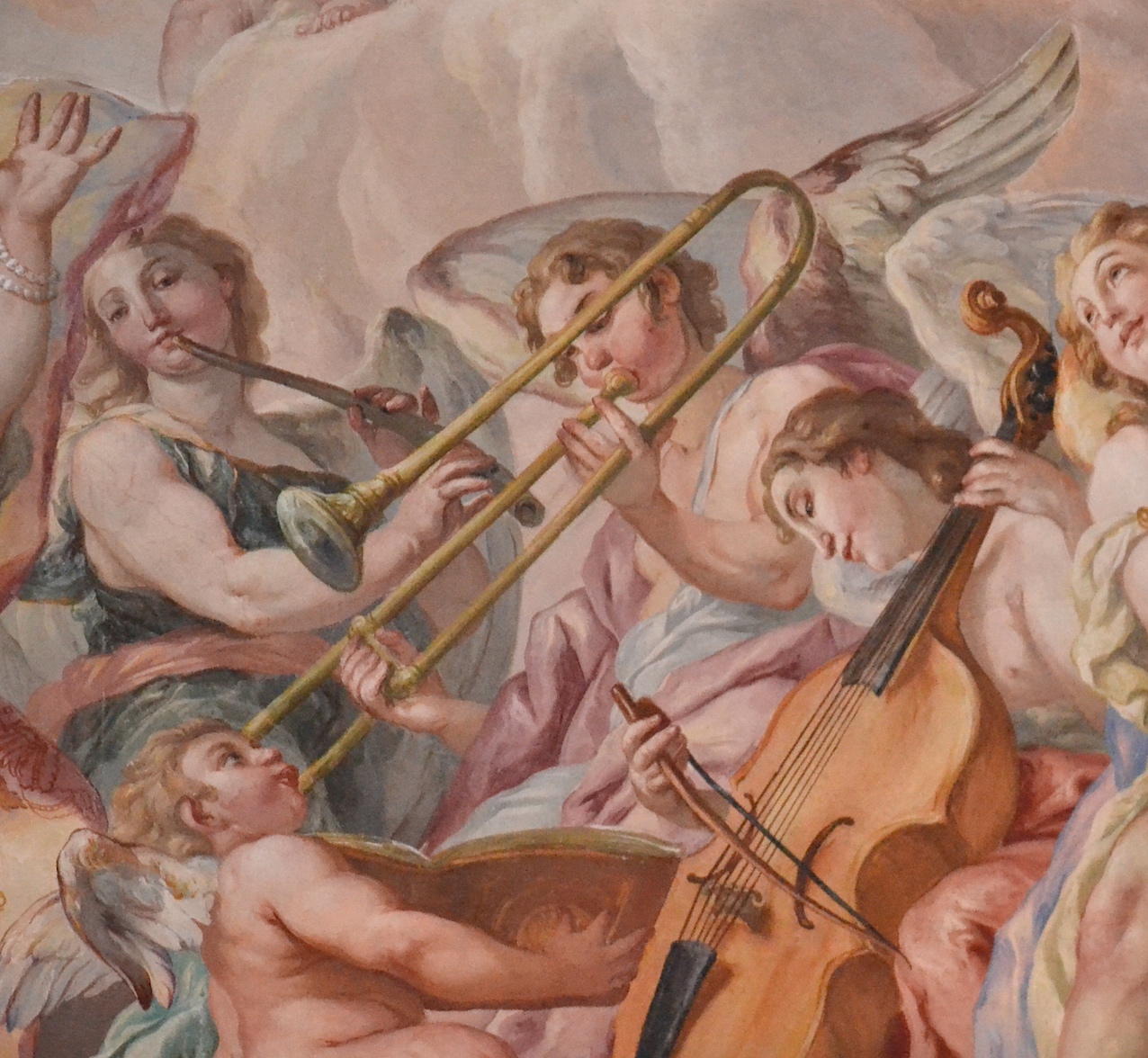
1725-40—Vienna, Austria: The Hofkapelle orchestra retains 4 trombones on its regular payroll (Selfridge-Field, Caldara 125).
1726—Vienna, Austria: Antonio Caldara’s aria, “Cosí a fiume” from Joaz, features solo alto voice with alto trombone obbligato (Carter, Trombone Obbligatos).
1726—Vienna, Austria: Johann Joseph Fux’s aria, “Venite, angioli” from Il testamento di nostro Signor Gesu Cristo al Calvario, features soprano and alto soloists with alto trombone obbligato (Carter, Trombone Obbligatos).
1726-1729—Valtice, Czech Republic: The Baroque castle chapel of the Valtice castle (also called Valtice chateau) is designed and decorated by Italian architect and artist Antonio Beduzzi. A fresco on the ceiling of the chapel includes a depiction of an angel playing the trombone (see below image; public domain) (special thanks to Richard Šeda).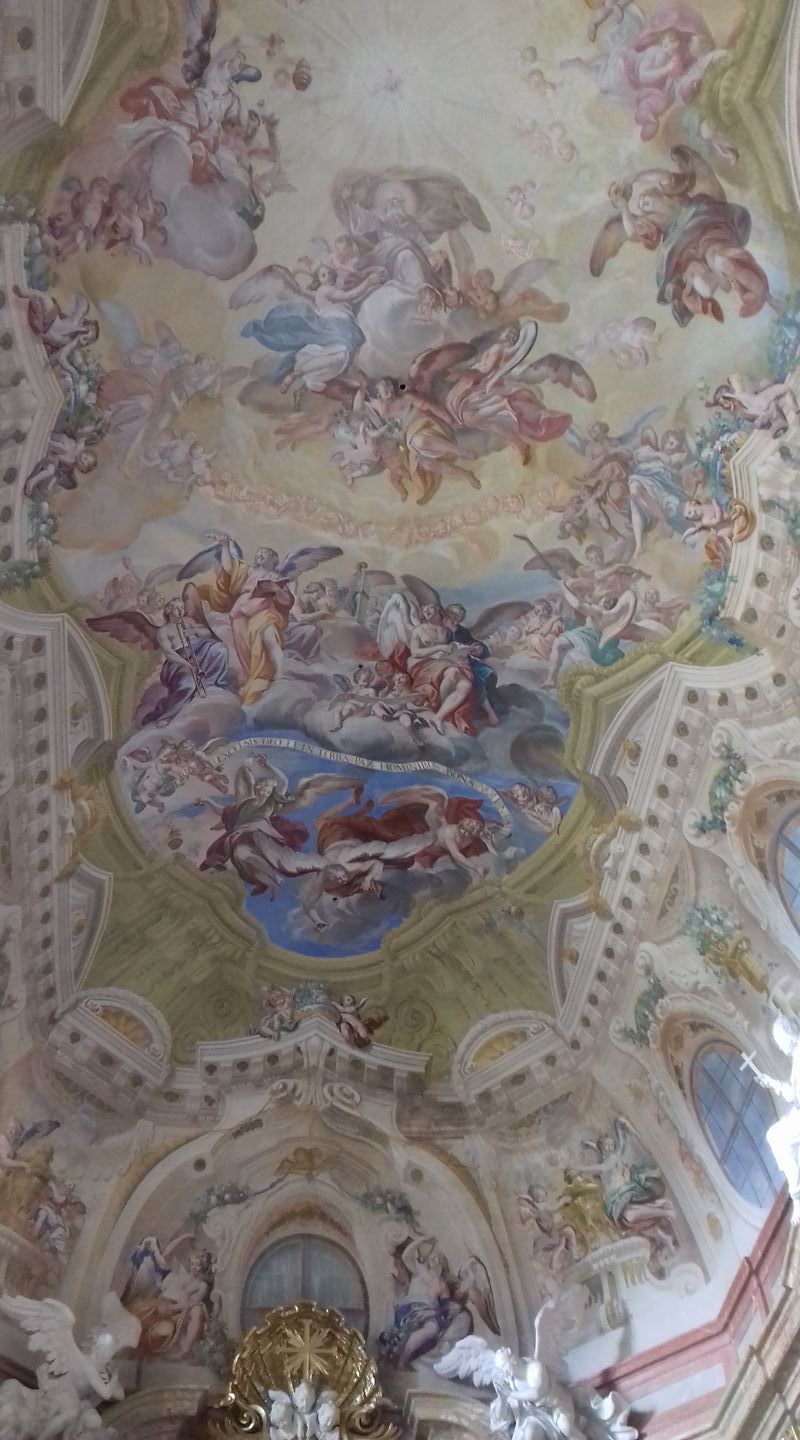
1727—Vienna, Austria: George Reutter’s aria, “Io ti do” from Abele, features solo alto voice with alto trombone obbligato (Carter, Trombone Obbligatos).
c. 1728—Vienna, Austria: Johann Joseph Fux composes the antiphon Alma Redemptoris for soprano voice and trombone. It contains one of the longest and most elaborate solos in a vocal work in the early trombone literature. The full score includes trombone, 2 violins, soprano voice, and continuo (Wigness 28).
1728—Vienna, Austria: Johann Joseph Fux’s aria, “Chi ti conosco” from La deposizione della croce, features alto trombone in an obbligato role (Carter, Trombone Obbligatos).
1728—Vienna, Austria: Georg Reutter’s aria, “Offesi, il veggo” from Elia, features solo alto voice with alto trombone obbligato (Carter, Trombone Obbligatos).
1728—Ephraim Chambers publishes his Cyclopaedia: or, An Universal Dictionary of Arts and Sciences. It goes through several editions in England and includes the following description: “The Sackbut is very fit for playing bass; and is contrived so as to be drawn out or shortened, according to the gravity or acuteness of the tones. The Italians call it Trombone, the Latins, Tuba Ductilis. It takes asunder into four pieces, or branches; and hath frequently a wreath in the middle; which is the same tube, only twisted twice, or making two circles in the middle of the instrument; by which means, it is brought down one fourth lower than its natural tone. It has also two pieces or branches on the inside, which do not appear, except when drawn out by means of an iron bar, and which lengthen it to the degree requisite to hit the tone required” (Guion, Trombone 34).
1728—Naumburg, Germany: Trombones are included in an inventory of St. Wenzel’s Church (Boydell, Crumhorn 99).
1728—Vienna, Austria: Georg Reutter’s aria, “Quanto t’offesi” from Bersabea, ovvero il pentimento di David, features solo tenor voice with obbligato alto trombone (Carter, Trombone Obbligatos).
1729—Bologna, Italy: According to Guion, “Trombonists were on the payroll of San Petronio in Bologna as late as 1729, apparently longer than in most major Italian churches.”
1729—Vienna, Austria: Antonio Caldara uses alto trombone as an obbligato instrument to accompany soprano voice in “Dio, qual sia la ria sentenza” of his oratorio, Naboth (Selfridge-Field, Caldara 138; Carter, Trombone Obbligatos).
1729—Vienna, Austria: Antonio Caldara uses alto trombone as an obbligato instrument to accompany alto voice in Missa Commemorationis (Selfridge-Field, Caldara 131).
1729—Vienna, Austria: Georg Reutter’s Mater dolorum, performed at the convent St. Agnes zur Himmelpforte, calls for a trombone. In the surviving parts the trombone’s single obbligato aria is labeled “Trombon: Alto solo. ô Talia,” suggesting an alternate instrument may have been used (Page, Convent Music 221).
1729—Klosterneuburg, Austria: Stiftskirche Klosterneuburg (the monastery church) features a fresco by Johann Michael Rottmayr that includes an angel-trombonist among a group of angel-musicians (see detail below; author’s personal photograph).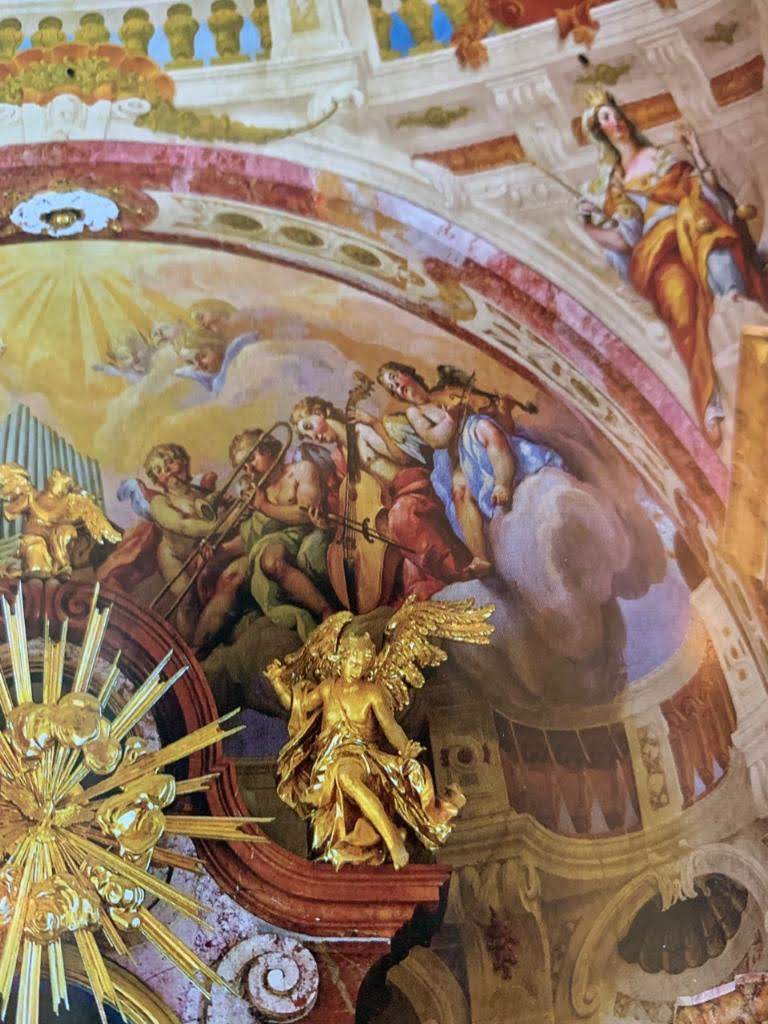
c. 1730—Melk, Austria: A fresco in the cupola of the Stiftskirche (Abbey Church) includes an angel playing trombone (see below image; public domain) (special thanks to Bruce Dickey).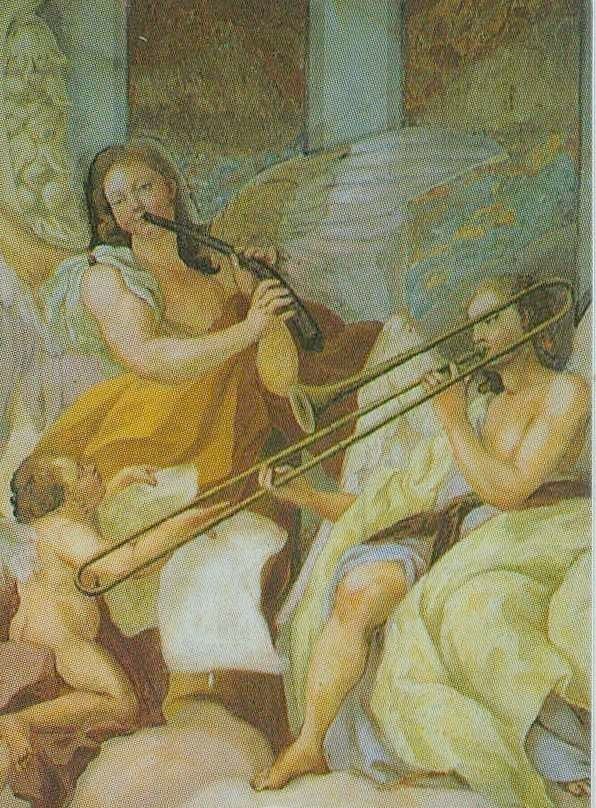
c. 1730—Salzburg, Austria: Matthias Biechteler (c. 1668-1743) writes Lytaniae de SS. Sacramento, which calls for 3 trombones (Rosenthal).
c. 1730—Salzburg, Austria: Carl Heinrich Biber writes Lytaniae de Venerabili Sacramento, which calls for 3 trombones (Rosenthal).
c. 1730—Johann Joseph Fux, Sonata à 3 (E 68) for trombone, 2 violins, and basso continuo. Performance edition available (Ensemble Pub).
c. 1730—Georg Philipp Telemann writes Sinfonia, an instrumental work for 3 trombones, cornetto, flute, oboe, viola da gamba, violin, 2 violas, violone, and continuo (Collver 70).
1730—Vienna, Austria: Stephan Tepser is hired as trombonist at the Imperial Court, a position he holds until he is pensioned and released in 1767 (Wigness 42; Selfridge-Field, Caldara 150).
1730—Leipzig, Germany: J.S. Bach, bemoaning the deteriorating quality of the local Stadtpfeifer (which includes trombone), complains that the players are “partly retired, and partly not at all in such practice as they should be” (Dickey, Cornett and Sackbut 100).
1730—Nuremberg, Germany: Doppelmayr gives an account of the early artists and mathematicians of Nuremberg, including brass instrument maker Hans Neuschel, the earliest know maker of the trombone (see 1497) (Bate 134).
1730—Vienna, Austria: Antonio Caldara uses alto trombone as an obbligato instrument with soprano voice in “Dovunque il guardo” of his oratorio, La passione di Gesu Cristo (Selfridge-Field, Caldara 138; Carter, Trombone Obbligatos).
1731—Carl Heinrich’s mass, Missa brevis sanctorum septum dolorum, calls for 3 trombones that double voices (Guion, Trombone 137).
1731—Salzburg, Austria: Carl Heinrich Biber writes Litaniae de Venerabili, which calls for 3 trombones (Rosenthal).
1731—Vienna, Austria: Antonio Caldara’s aria, “Del fallo m’avvedo” from La morte d’Abel, features alto voice with obbligato alto trombone (Carter, Trombone Obbligatos).
1731—Vienna, Austria: Antonio Caldara uses alto trombone as an obbligato instrument in his aria, “Dal tuo seglio luminoso” from Santa Elena al Calvario (Carter, Trombone Obbligatos).
1731—Herrnhut, Germany: Several residents from the Moravian village of Herrnhut visit nearby Berthelsdorf to serenade Pastor Rothe on his birthday with trombones. Later that year, trombones accompany the singing of a chorale to celebrate the arrive of colleagues from Moravia. Still later that year, trombonists accompany voices at a funeral in Herrnhut: “First they sang Mein edler Geist and afterward Wie schön ist unsers Königs Braut, and at the interment, Die Seele Christi heilge mich–all to the accompaniment of trombones.” Herrnhut, incidentally comes to function as the spiritual and administrative center of the Moravian faith (Carter, Trombone Ensembles of the Moravian).
c. 1732—Salzburg, Austria: Matthias Biechteler (c. 1668-1743) writes Lytaniae de SS. venerabili Sacramento, which calls for 3 trombones (Rosenthal).
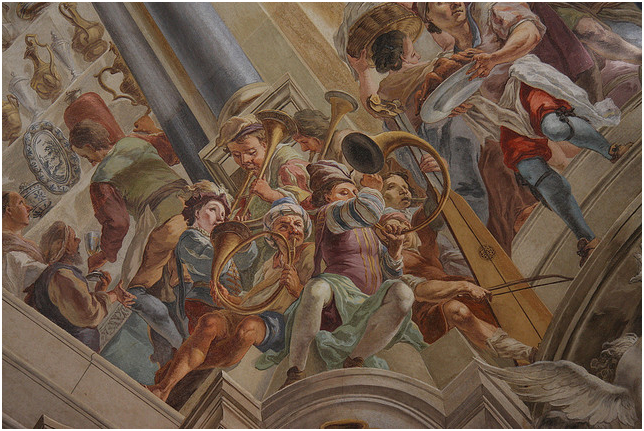 1732—Prague, Czech Republic: Upon restoration of the Strahov monastery, monk-artist Siard Nosecky paints a fresco on the refectory ceiling that includes what appear to be two rear-facing trombones along with two horns and a tromba marina (see above image; public domain).
1732—Prague, Czech Republic: Upon restoration of the Strahov monastery, monk-artist Siard Nosecky paints a fresco on the refectory ceiling that includes what appear to be two rear-facing trombones along with two horns and a tromba marina (see above image; public domain).
1732—Manufacture date of a bass trombone made by Johann Leonard Ehe and held at Nuremberg, Germanisches Nationalmuseum. The horn includes 2 noteworthy features: 1) a loop in the U of the bell section to accommodate tubing required to lower the pitch, and 2) a bell section with a more marked terminal flare than most other instruments of earlier manufacture (Gregory 34).
1732—Vienna, Austria: Pietro Casati, Salve Regina.
1732—Venice, Italy: At St. Mark’s, when cathedral trombonist Lodovico Vaccio dies, he is replace by a trumpeter, because, in the words of the Procurators, trumpet is “an instrument better adapted to the use of modern orchestras [concerti].” Historian Denis Arnold points out that the Procurators were actually saving money with this change: whereas the new trumpeter was to be hired at a salary of 15 ducats a year, trombonists were usually paid 50 ducats (Arnold, Orchestras in Eighteenth-Century Venice).
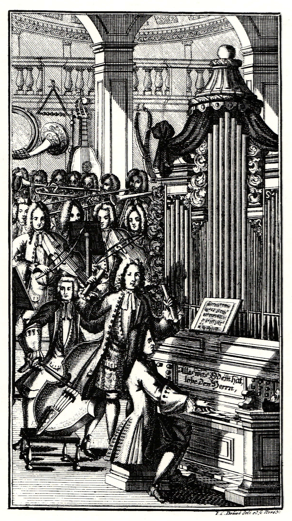 1732—Leipzig, Germany: An engraving by Johann Christoph Dehne called Performance of a Bach Cantata, the frontispiece from Johann Georg Walther’s Musikalisches Lexicon, clearly includes a trombonist in a performance of sacred music in the Weimar church (see facing image; public domain) (Naylor 72; Buchner 1973).
1732—Leipzig, Germany: An engraving by Johann Christoph Dehne called Performance of a Bach Cantata, the frontispiece from Johann Georg Walther’s Musikalisches Lexicon, clearly includes a trombonist in a performance of sacred music in the Weimar church (see facing image; public domain) (Naylor 72; Buchner 1973).
1733—Vienna, Austria: Antonio Caldara uses alto trombone as an obbligato instrument the aria “Buon Gesú” of his oratorio, Gerusalemme convertito (Selfridge-Field, Caldara 138; Carter, Trombone Obbligatos).
1733—Salzburg, Austria: Carl Heinrich Biber writes Litaniae de Venerabili Sacramento, which calls for 3 trombones (Rosenthal).
1734—Salzburg, Austria: Matthias Biechteler (c. 1668-1743) composes Lytaniae de venerabili sacramento a 4 voci con stromti, which calls for 3 trombones (Rosenthal).
1734—George Reutter’s Missa Sancti Caroli includes a solo movement, “Gratias agimus tibi,” for alto voice, that features virtuoso passagework for the alto trombonist (Guion, Trombone 131).
1734—Vienna, Austria: Antonio Caldara uses alto trombone as an obbligato instrument the aria “Dov’é giá sviene” from his oratorio, San Pietro in Cesarea (Selfridge-Field, Caldara 138; Carter, Trombone Obbligatos).
1734—Vienna, Austria: Georg Reutter’s aria, “Ah se o da vivere” from Gioas, Ré di Giuda, features solo soprano voice with obbligato alto trombone (Carter, Trombone Obbligatos).
1735—Salzburg, Austria: Carl Heinrich Biber writes Litaniae de Venerabili Sacramento, which calls for 3 trombones (Rosenthal).
1736-37—Leipzig, Germany: J. S. Bach’s Cantata No. 118 (O Jesu Christ, mein’s Lebens Licht), written for the funeral of Joachim Friedrich von Fleming, governor of the city of Leipzig, requires trombones. The specific instrumentation is 2 litui, 1 cornett, and 3 trombones. Trombones are treated independently and do not double the vocal parts (Guion, Trombone 201).
1736—Vienna, Austria: Antonio Caldara uses alto trombone as one of several obbligato instruments in his setting of Psalm 111/112, Beatus vir qui timet Dominum (Selfridge-Field, Caldara 134).
1736—Vienna, Austria: Leopold Ferdinand Christian is appointed trombonist at the Imperial Court, a position he holds until he is given a pension and released in 1771 (Wigness 41; Selfridge-Field, Caldara 147).
1737—Chemnitz, Germany: Johann Christoph and Johann David Stössel, in their Kurtzgefasstes musicalisches Lexicon, include the following about trombone: “They are of various sizes, according to the voice that they serve, and have a sound that is less sharp and more lovely than the trumpet’s” (Guion, Trombone 37).
1738—Vienna, Austria: Luca Antonio Predieri’s aria, “Dio sol ne porge aita” from I Sacrificio d’Abramo, features solo alto voice with alto trombone obbligato (Carter, Trombone Obbligatos).
1738—Handel uses trombones in 2 oratorios, Saul (in 4 choruses and 4 instrumental movements) and Israel in Egypt (in 10 choruses). Anthony Baines later calls the trombone parts in Saul the finest in the 18th century (Guion, Trombone 144).
1738—Johann Philipp Eisel, in his text Musicus autodidactos, oder der sich selbst informirende Musicus, includes the following: “What is to be noted concerning the clefs? Nothing more than this, that the alto trombone has the alto clef as prescribed in the parts, where as the quint and quart trombones generally have the bass clef as prescribed in the parts” (Guion, Trombone 44).
1738—Salzburg, Austria: Carl Heinrich Biber writes Litaniae de Venerabili Sacramento, which calls for 3 trombones (Rosenthal).
1739—Hamburg, Germany: Johann Mattheson asks, “Why then do the good cornetts and trombones, which were formerly closely related and were highly esteemed as staples by the expert fifers as well as the composers, seem to be banished now so completely from the churches, at least from the ones here, as if they had been discovered to be incompetent? For the former instrument is still very penetrating, with all its harshness; whereas the other sounds very majestic, and fills a large church beautifully” (Mattheson, Capellmeister 846).
c. 1740—The trombone bell is widened to produce a stronger sound (Remnant, Illustrated 157).
c. 1740—According to Bate, the trombone bell begins to show much more terminal flare by about this year. In fact, Bate asserts, “though we must make allowance for individual variation between different workers, we may say that the instrument had at this time assumed its modern form” (Bate 139).
c. 1740—Vienna, Austria: Wagenseil composes his Missa Transfige cor meum, which contains the unusual accompaniment of 2 violas or trombones and continuo (Mac Intyre 92).
c. 1740—Vienna, Austria: Franz Tuma composes Missa in chordis et organo in G. The “Gratias” consists of solo alto voice, 2 trombones playing soloistic obbligato parts, and continuo (Mac Intyre 292).
c. 1740—Dresden, Germany: Bohemian composer Jan Dismas Zelenka, an important contemporary of Bach and Handel, composes his Requiem in C Minor. The piece utilizes 3 trombones, which perform in every movement, often doubling the lower vocal lines (Chase 181). Trombones, which are the only brass in the work, play a particularly prominent role in the “Dies Irae.”
1740—Vienna, Austria: By this date, the practice of using trombones to augment forces at the Ursuline convent is well established, with sets of parts that often include a pair of trombones” (Page, Convent Music 84).
1740—Coburg, Germany: A Schuke organ is installed in St. Moriz Church. Atop the pipes are two angel-trombonists (see below image; public domain).
1741—Leipzig, Germany: Johann Heinrich Zedler writes, “Posaune…is used by the Stadtpfeifer of Thuringia in the towers, city hall corridors, in church music, and for other occasions…They have a sound more lovely than, if not as sharp, as the trumpet’s, and are used for church and table music” (Guion, Trombone 48-49).
1741-60—Vienna, Austria: The Hofkapelle orchestra retains 5 trombones on its regular payroll (Selfridge-Field, Caldara 125).
1741—Vienna, Austria: Maria Theresa succeeds to throne at the Imperial Court. Shortly after gaining the throne, she becomes involved in a long and costly war, necessitating the release of a large part of the court orchestra, including 2 of the 4 trombones (Wigness 3).
1741—Vienna, Austria: Georg Christoph Wagenseil writes Missa Sancti Antonii, which utilizes 2 trombones as obbligato instruments in the “Et incarnates” and “Agnus Dei” (Mac Intyre 671).
1741—Salzburg, Austria: Matthias Biechteler (c. 1668-1743) writes Lytaniae de venerabili Sacramento, which calls for 3 trombones (Rosenthal).
1741—England: An announcement for a benefit concert for trumpeter Valentine Snow proclaims that the concert will include “the Dead March in Saul to be performed with Sackbuts” (Guion, Trombone 146).
1741-83—Vienna, Austria: Trombone is frequently used for obbligato and choral doubling roles in sacred music, particularly in “Gratias” and “Agnus Dei” movements (Mac Intyre 566).
1742—Bologna, Italy: A miniature from Le Insignia degli Anziani Consoli (vol. XIII, c. 156, 1742) depicts a reception in honor of Carlo Emanuele III of Sardinia in the Palazzo d’Accursio’s Galleria degli Anziani. Among the instruments pictured in the orchestra is a trombone (see detail and full image below; public domain) (Bologna Archivio di Stato; special thanks to John Manganaro, horniconography.com).
1742—Vienna, Austria: Franz Ignaz Tuma, Sonata a 2 violini e 2 tromboni.
1742—Vienna, Austria: Franz Tuma’s Messa della morte is performed. The requiem requires a solo alto trombone with solo alto voice in the “Tuba mirum” section (Smithers, Mozart’s Orchestral Brass).
1743—Vienna, Austria: Georg Christoph Wagenseil uses 2 trombones in an obbligato role in his Missa solenne Immaculatae Conceptionis (Mac Intyre 674).
1743—Vienna, Austria: On St. Leopold’s day the chronicler at the Ursuline convent records, “There were trumpets and timpani for both Litanies, and also for the Mass, but there only the fanfares. For the first Litany and at Mass there were trombones [posannen]” (Page, Convent Music 218).
1743—Vienna, Austria: On the feast of St. Ursula the chronicler at the Ursuline convent records, “at both Masses we had trombones, but we did not have them for Second Vespers” (Page, Convent Music 219).
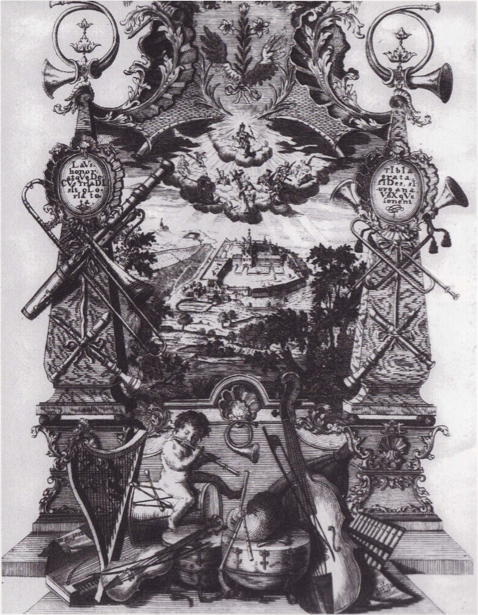 1743—Burghausen, Germany: The title page of Albertus Hirschberger’s Philomena Cisterciensis includes a depiction of a trombone (see facing image; public domain) (Bowles, The Timpani 214).
1743—Burghausen, Germany: The title page of Albertus Hirschberger’s Philomena Cisterciensis includes a depiction of a trombone (see facing image; public domain) (Bowles, The Timpani 214).
1743—Zeitz/Leipzig, Germany: The Stadtpfeifer has an opening. They commission Johann Gottlieb Görner, the Leipzig university music director, to write a test composition that contains one solo section for each of the following wind instruments (with string accompaniment): trumpet, alto trombone, cornett, violin, oboe, and horn (Collver 51; Nicholson, The Unnatural Trumpet).
1743—Vienna, Austria: Franz Tuma’s Messa della morte is again performed. The requiem requires a solo alto trombone with solo alto voice in the “Tuba mirum” section (Smithers, Mozart’s Orchestral Brass).
1744—Salzburg, Austria: Carl Heinrich Biber writes Litaniae de Venerabili Sacramento, which calls for 3 trombones (Rosenthal).
1744-5—Gabriel Weiss depicts trombones in the 6th panel of a 6-panel series of paintings of angel musicians (Downey, Instrumental Iconography).
c. 1745—Vienna, Austria: Ferdinand Schmidt, Kapellmeister at St. Stephens, composes Missa Primitiarum in C. The “Qui tollis” features 2 trombones in a prominent obbligato role (Mac Intyre 262).
c. 1745—Vienna, Austria: Franz Tuma, in his Missa Tibi soli di Psalm 50, writes expressive obbligato lines for the 2 trombones (Mac Intyre 504).
1745—Salzburg, Austria: Heinrich Pichler, a student at the Benedictine University, describes a Vespers service at the Salzburg Cathedral performed by an orchestra of 3 trombones, 2 organs, 2 bassoons, 3 basses, and 12 violins. Also included are solo and ripieno singers, 6 trumpets, and timpani. The performers are spread over 5 different lofts throughout the cathedral (Eisen, Mozart’s Salzburg Orchestras).
1746—Salzburg, Austria: For major feasts the cathedral orchestra consists of just over 20 players, in addition to trumpets and timpani. For lesser feasts, the orchestra performs in only one loft and is reduced to 3 trombones, 1 bassoon, and 5 strings (Eisen, Mozart’s Salzburg Orchestras).
1746—Vienna, Austria: The chronicler for the Ursuline convent reports that, because of a decree that no trumpets or timpani are to be used for liturgical services, “Sister Maria Francisca’s profession ceremony took place…along with our musicians there was nothing else but the trombonists [possaunen]” (Page, Convent Music 209).
1745—Vienna, Austria: A solemn festival of thanksgiving upon completion of the Ursuline convent features a High Mass and Te Deum with trumpets, timpani, and trombones (Posanen). These instruments also play for Vespers (Page, Convent Music 25, 209).
1746—Naples, Italy: Statutes of the Pieta dei Turchini specify where each musical instrument is to be taught, “the class of trombones and trumpets in the lower cloakroom” (Arnold, Instruments and Instrumental Teaching; Guion, Missing Link).
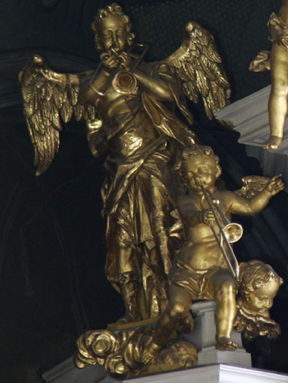 1746—Prague, Czech Republic: An organ by Tomas Schwarz is completed and installed in St. Nicholas Cathedral. Atop the pipes of the organ are numerous angels playing musical instruments, including trombones (see facing image; public domain).
1746—Prague, Czech Republic: An organ by Tomas Schwarz is completed and installed in St. Nicholas Cathedral. Atop the pipes of the organ are numerous angels playing musical instruments, including trombones (see facing image; public domain).
1747—Vienna, Austria: The Imperial Court has 5 trombonists: Christian, Loog, Stainprugger, Tepsser, and Leopold Ferdinand Christian (Herbert, Sackbut 80).
c. 1748—Wilhering, Austria: Decorations surrounding the organ in Wilhering Abbey feature a trophy of musical instruments that includes both a trombone and a cornetto (see detail and full image below; public domain).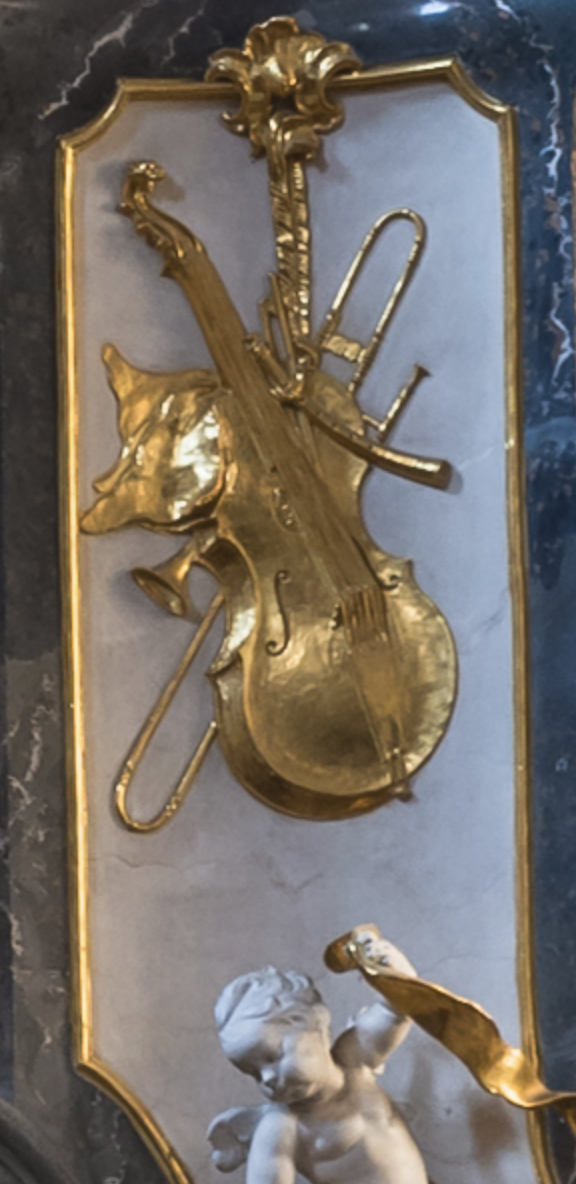
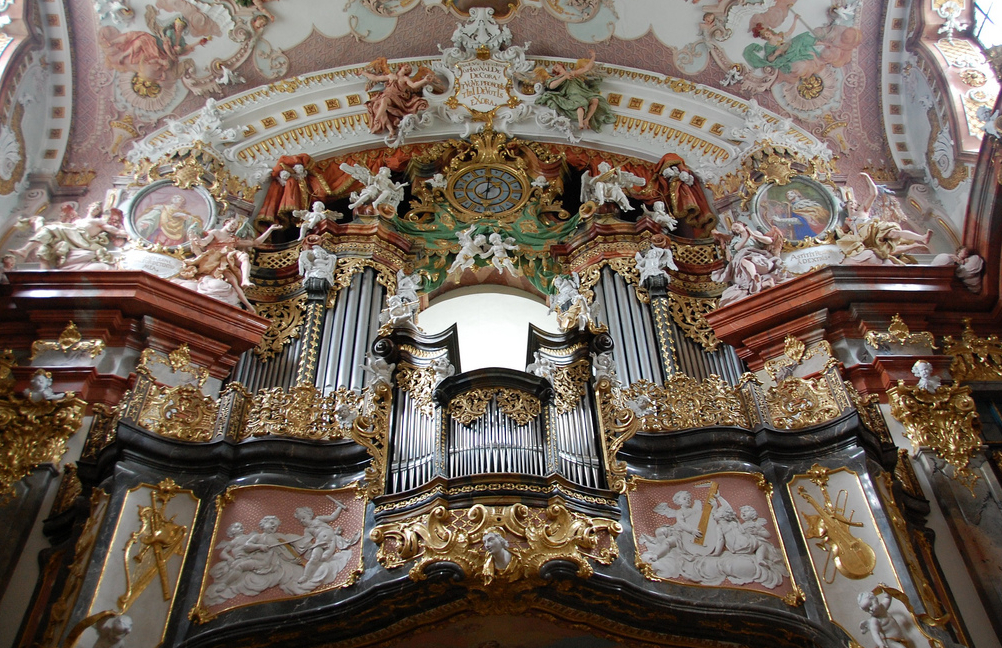
1749—France: In the earliest documented use of trombone in a French orchestra, a letter from the Comte de Clermont to the Comte de Billy names the trombone (even using the term “trombone,” not “sackbut”) among 28 instruments in his orchestra (Guion, Trombone 168).
mid-1700s—Germany: Reorganization of military bands gives trombone the role of strengthening bass line. Trio maintained in large infantry bands and in orchestras. Technical changes include realignment of the old high A pitch (of the tenor) to concert and band pitch Bb and acceptance of seven chromatic slide positions instead of the previous diatonic positions.
mid-1700s—Although each nation has its own ideal in terms of the instrument’s bore size, etc., greater terminal flare of the bell is adopted universally (Remnant, Illustrated 151).
1750—Vienna, Austria: At the Ursuline convent, music for the celebration of Mass on the feast of Philip and James includes trombones (pusunnen) (Page, Convent Music 84).
1751—Vienna, Austria: At the Ursuline convent, on the feast of the Sacred Heart of Jesus, the convent chronicler reports, “we had no trumpets this year; at the service we had nothing but trombones.” The same holds true of other important feasts of the year: the abbess’s name day, St. Mathias, and St. Ursula (Page, Convent Music 212).
1751—Vienna, Austria: Trombones are used for a Requiem Mass at the Ursuline convent (Page, Convent Music 220).
1752—Canterbury, England: An inventory from the Canterbury Cathedral lists “two brass Sackbuts not used for a great number of years past” (Guion, Trombone 151).
1752—Sainte-Croix, Switzerland: The town council draws up a contract with 5 Jaccard brothers to play “saquebutes, hautbois and bassons for the singing of Psalms on every Sunday and annual feast days” for the sum of 90 Florins per year. Two years later, Pierre Jaccard, father of the 5 Jaccard brothers, establishes the Jaccard Family Charitable Fund, the founding document of which says, “In order to augment the funds, I counsel my children to continue to play their sackbuts [saquebutes] and other musical instruments in the church and to apply those wages annually to increase the capital of said Society.” The children scrupulously observe their father’s council, making regular deposits in the “Charitable Fund” until the year 1762 (Burdet, Canton Vaud; special thanks to Jerry-Louis Jaccard, translator).
1753—Vienna, Austria: George Reutter writes his Requiem in C Minor, which calls for 2 trombones. In addition to doubling vocal lines, trombones play numerous fanfares and obbligatos. The “Tuba Mirum,” scored for 2 trombones, soprano, alto, tenor, and bass voices, and continuo, is probably the earliest known composition of its kind to designate the “Tuba mirum” be performed by trombones. It features a virtuosic trombone solo that accompanies the solo for alto voice. The title page bears the inscription “con tromboni Soli” (Chase 171; Wigness 30).
1753—Vienna, Austria: Trombones are hired to play at the Ursuline convent with the convent’s musical ensemble on the abbess’s name day (Page, Convent Music 218).
1753—Vienna, Austria: On St. Ursula’s day at the Ursuline convent, the convent chronicler reports, “trumpets and timpani as well as trombones played for the Mass…for First Vespers [on the eve of the feast] as well as [Vespers] on the feast itself, only the trombones [possounen] played” (Page, Convent Music 213).
1754—Vienna, Austria: Trombones are added as extra musicians for a ceremony at the Ursuline convent (Page, Convent Music 27).
1754—Vienna, Austria: Trombones are used for a Requiem Mass at the Ursuline convent (Page, Convent Music 220).
1754—Würzburg, Germany: The Prince-Bishop of Würzburg decrees that “private persons may not make use of trumpets and kettledrums at public festivities.” Instead, all subjects must “restrict themselves to their usual stringed and musical instruments, horns, and trombones.” Those who defy this decree are “subject to severe punishment” (Salmen, Status).
1754—Bethlehem, Pennsylvania: Trombones play for the first time in the community of Bethlehem, during the August 31 celebration of the Single Brothers’ Festival. The 4 trombones they use—a soprano, an alto, a tenor, and a bass—are presumably new instruments purchased recently from Europe (Peucker, The Role 174; Guion, Trombone 125). Later the same year they play their first funeral observance (Carter, Trombone Ensembles of the Moravian).
1754—Einsiedeln, Switzerland: The choir organ in Einsiedeln Abbey church is built. It is probably at this time that the organ is decorated as well, including a cherub holding a trombone (see detail and full image below; photos courtesy of Lukasz Michalski).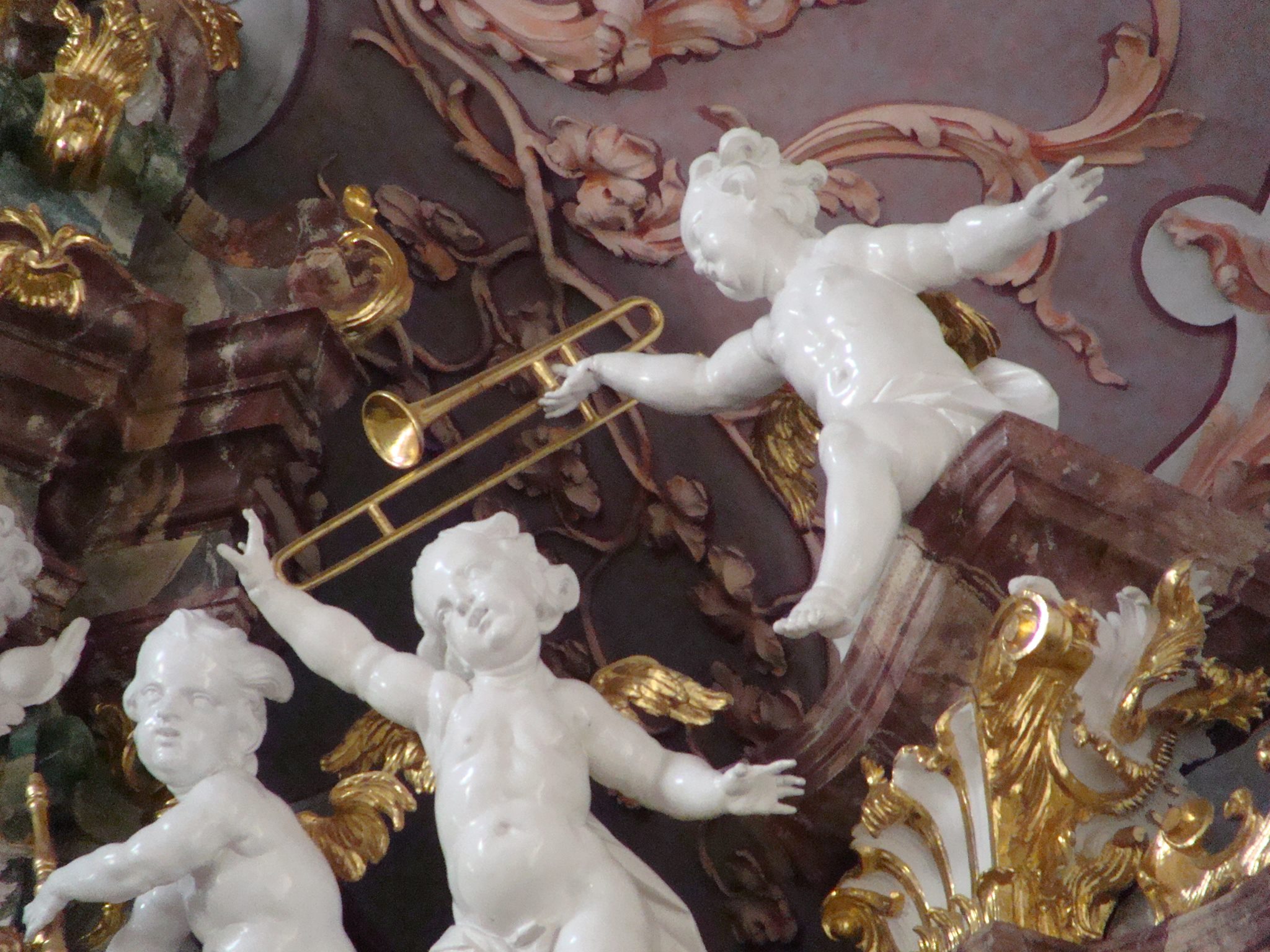
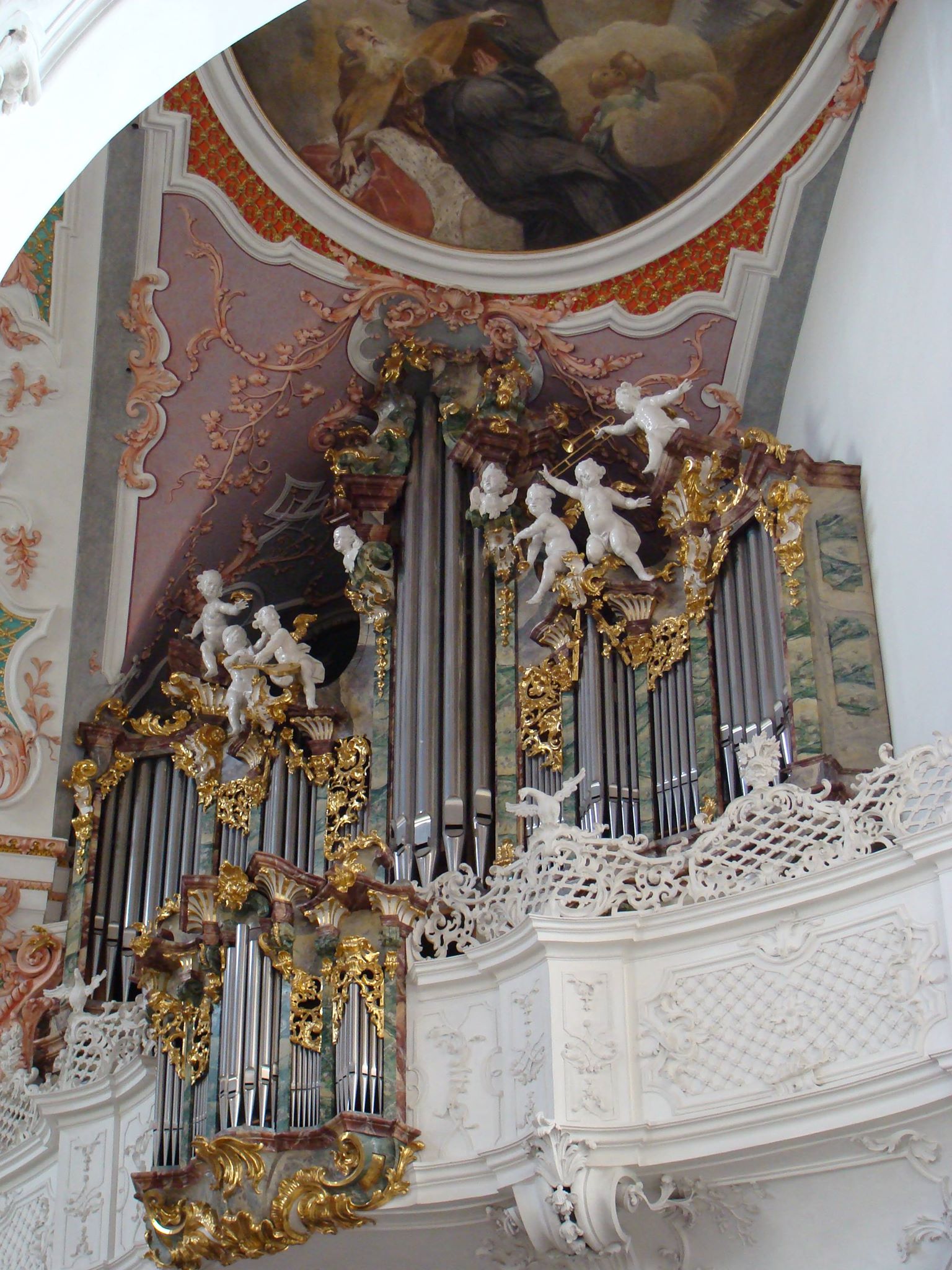
1755—Eberlin composes the oratorio, Der blutschwitzende Jesus, which utilizes trombone in a soloistic manner (Guion, Trombone 137).
c. 1755—Vienna, Austria: Georg Wagenseil, court composer at the Imperial Court, writes Concerto for alto trombone (Wigness 19).
c. 1755—Vienna, Austria: Johann Nepomuk Boog, regens chori at St. Peter’s, uses trombone in sacred works for choral doubling and occasional obbligatos (Mac Intyre 60).
c. 1755-85—Leipzig, Germany: Johann Friedrich Doles, a former student of J.S. Bach and successor to Bach at Leipzig, writes 27 works that call for all four sizes of trombones (soprano, alto, tenor, bass) (Carter, Trombone Ensembles of the Moravian).
1755—Bethlehem, Pennsylvania: According to local legend, trombones ward off an Indian attack in the early morning of Christmas Day. Indians supposedly interpret the sounds of the Moravian trombone choir playing a chorale as a sign that the Great Spirit will protect the Moravians and abandon their plans for an attack (Carter, Trombone Ensembles of the Moravian).
1756—France: Jean-Jacques Rousseau, in his Encyclopédie, our Dictionnaire raisonné, says the following about the trombone: “It serves as the bass in all kinds of consorts of wind instruments, as do the serpent and the bassoon, and it serves as baritone to the oboe” (Guion, Trombone 67).
1757—Zittau, Germany: Following the destruction of the Johanniskirche and all its musical instruments, one of the church’s first purchases is a set of 4 trombones (Carter, Trombone Ensembles of the Moravian).
1757—Salzburg, Austria: Leopold Mozart, writing in a register of Salzburg Court Musicians, describes trombonist Thomas Gschlatt as a great master (Donley Thomas).
1757—Salzburg, Austria: There is one permanent trombone in the Salzburg Kapelle (Spitzer Ap B).
1757—Salzburg, Austria: Leopold Mozart authors a “Report on the Present State of the Musical Establishment at the Court of His Serene Highness the Archbishop of Salzburg,” wherein he makes the following comment about trombones: “To the choir singers belong, finally, three trombonists, namely, to play the alto-, tenor- and bass-trombone, which must be taken care of by the master of the town waits with two of his subordinates (Eisen, Mozart’s Salzburg Orchestras).
1757—Georg Reutter composes Per mundi castra velox ad astra, in which he calls for 2 trombones (Collver 155).
1757—The Moravian Litaneyen-Büchlein (liturgy book) states, “In places where the home-going of Brothers and Sisters is announced by trombones, this consists of the melody O Haupt voll Blut und Wunden, repeated twice. Between [these two repetitions] a melody is played, from which one can recognize the choir from which [the deceased] has so mercifully been called home” (Carter, Trombone Ensembles of the Moravian).
c. 1758—Austria: Leopold Hofmann alternates strings with trombones and continuo in his Missa in Honorem Sanctae Theresiae in C (Cameron 83).
1759—Ubaque, Colombia: Ubaque valley churches possess large ensembles of European musical instruments, including trombones, portative and fixed organs, clavichords, harps, guitars, violins, violoncellos, shawms, dulcians, flutes, and trumpets (Bermúdez, Gold was Music).
1759—Vienna, Austria: Franz Tuma’s Messa della morte is again performed. The requiem requires a solo alto trombone with solo alto voice in the “Tuba mirum” section (Smithers, Mozart’s Orchestral Brass).
1759—Georg Reutter composes several works that use trombone, all of which call for 2 trombones: Ergo plebs fidelis, Succure rex coelorum, and Dei nomen magnificate (Collver 155).
c. 1760—Frankfurt, Germany: According to his autobiography, Goethe, the famous author and poet, attends a Pfeifergericht (piper’s court), the opening ceremony of the Frankfurt fair. The ceremony, which Goethe witnesses as a child, includes the Stadtpfeifer, at this time already a very old convention (“the advent of former centuries,” in Goethe’s words). The ensemble, which hails from Nuremberg, probably consists of shawm, sackbut, and pommer. Goethe writes: “All at once a singular sort of music announces, if we may so speak, the advent of former centuries. It proceeds from three pipers, one of whom plays an old shawm, another a sackbut, and the third a pommer, or oboe. They wear blue mantles trimmed with gold, having the notes made fast to their sleeves, and their heads covered….They were always the same antiquated virtuosi whom Nuremberg, for itself and its co-cities, had undertaken to maintain, and produce annually at the appointed place.” The many editions of John Oxenford’s translation of the autobiography render Goethe’s German word Bass as sackbut in this passage (Goethe-Oxenford, 19-20), while the R. O. Moon translation renders it bassoon (Goethe-Moon, 15). The original German phrase describing the 3 instruments is “eine alte Schalmei, der andere einen Bass, der dritte einen Pommer oder Hoboe blast” (Goethe).
c. 1760—In Vienna, Georg Christoph Wagenseil writes “Memoriam” (from Confitebor) for alto trombone, alto voice, and orchestra (Wagenseil).
c. 1760—Vienna, Austria: Joseph Krottendorfer, a member of the Hofkapelle, writes his Missa in C, in which a single, florid solo trombone accompanies the alto soloist in the “Agnus Dei” movement (Mac Intyre 80, 508).
1760—Netherlands: Johann Heinrich Danki is working in the fields on a farm located just outside the Moravian community of Zeist. In the distance, Danke hears trombones playing a familiar German tune. When Danki inquires of the farmer about the music, the farmer responds, “That is in Zeist with the Herrnhuters.” Danke subsequently visits a religious service in Zeist and converts to the Moravian religion (Peucker, The Role 169).
1760—Olmütz, Bohemia: The music inventory of Prince-Bishop Leopold Egk includes 3 anonymous trombone concertos, now lost (Guion, Trombone 143).
1760—Paris, France: François-Joseph Gossec composes Messe des morts, a Requiem Mass first performed at the Jacobean monastery of the rue St. Jacques, and subsequently performed at least a dozen times in Paris before the Revolution. Three trombones, along with several other wind instruments, appear offstage in the “Tuba mirum” (see 21:15 in the recording below; Guion, Trombone 169; Chase 200). Later, Gossec makes the following comment about the piece: “In the two strophes Tuba mirum and Mors stupebit et natura of the Dies irae, people were frightened by the terrible effect of three trombones with four clarinets, four trumpets, four horns, and eight bassoons hidden in the distance and in an elevated place in the church to announce the last judgment” (Guion, Trombone 170).
1760—Vienna, Austria: In this year or earlier, Marianna Martines writes her Mass No. 1 (Messe no. 1), where the two trombones double inner choral parts (Godt 35, 37).
1760—Vienna, Austria: Marianna Martines writes her Mass No. 2 (Seconda messa in G) where the two trombones mainly double inner choral parts but are featured on obbligato parts in the Benedictus (Godt 35, 37).
1761—Vienna, Austria: Marianna Martines writes her Mass No. 3 (Terza messa), where the two trombones mainly double inner choral parts but are featured on obbligato parts in the Benedictus, accompanying a tenor solo (Godt 35, 37, 45; Godt Chronology).
1761—Georg Reutter composes Quae festiva nobis lucet and Laudate Deum, both of which call for 2 trombones (Collver 155).
1761—Vienna, Austria: Gluck uses trombone (a single alto trombone) prominently in his ballet Don Juan (Guion, Trombone 229).
1761—Canterbury, England: An inventory from the Canterbury Cathedral lists “two brass Sackbuts not used for a great number of years past” (see also 1752) (Guion, Trombone 151).
1761—London, England: The Royal Magazine or Gentleman’s Monthly Companion prints “A Succinct Account of the Coronation of their most Excellent Majesties King George III and Queen Charlotte, on Tuesday the 22d of September 1761.” The description of the procession leading from Westminster Hall to the Abbey includes 2 Sackbuts situated on either side of “A double Courtal” (Succinct Account 109-110).
1761—Bologna, Italy: after a brief respit, San Petronio Cathedral begins using trombone again, continuously employing one trombonist until 1893 (Guion, Short History).
1761—Vienna, Austria: Marianne von Martínez, one of the first female composers in the region to win serious recognition, writes Terza Messa. In the “Benedictus” movement, 2 solo trombones accompany the tenor soloist (Mac Intyre 81, 631).
1761—Dresden, Germany: A tenor trombone is made by Johann G. Leudholdt of Dresden and purchased by the Moravian Brethren in North America (possibly Bethlehem, Pennsylvania). At one point the property of the Schoeneck church, it is now housed in a collection of musical instruments owned by the Moravian Historical Society in Nazareth, Pennsylvania, and is considered the oldest surviving trombone known to have been used in the Western Hemisphere (Carter, Trombone Ensembles of the Moravian).
1761-2—Vienna, Austria: The Hofkapelle orchestra retains 4 trombones on its regular payroll except for one year (1708), when it temporarily drops to 4 (Selfridge-Field, Caldara 124).
1762—Leopold Mozart, Concerto for alto trombone or viola (part of larger Serenata).
1762—Georg Reutter composes several works that use 3 trombones: Ad te levavi animam meam, Deo sit laus, De manu peccatorum, and Si observaveris iniquitates (Collver 154).
1762—Christianspring, Pennsylvania: The Moravian settlement purchases a set of trombones from their nearby neighbors in Bethlehem (Carter, Trombone Ensembles of the Moravian).
c. 1763—Michael Haydn composes Larghetto for alto trombone as part of his incomplete Sinfonia No. 4. The full title for the trombone movement is “Larghetto a Trombone Concerto” (Guion, Trombone 140). It is possibly written for Salzburg trombonist Thomas Gshlatt (Donley Thomas).
1763—Gnadenberg and Herrnhut, Germany: Accounts of Moravian settlements in Germany mention use of trombone accompaniment for congregational singing at peace festivals (Gombosi, A Day of Solemn Thanksgiving 189, 208). An account of a service at Herrnhut gives the following description: “The entire congregation under the pealing trumpets and trombones repeated these words: Ihn ewiglich” (Gombosi, A Day of Solemn Thanksgiving 201).
1763-64—London, England: The entry for Sackbut in A New and complete dictionary of arts and sciences is noteworthy because it describes the instrument, even at this late date, as “a sort of trumpet,” and because it mentions multiple sizes of trombones: “Sackbut, a musical instrument of the wind-kind, being a sort of trumpet, though different from the common trumpet both in form and size: it is fit to play a bass, and is contrived to be drawn out and shortened, according to the tone required, whether grave or acute. The Italians call it trombone, and the Latins tuba ductilis….There are sackbuts of different sizes, distinguished by the epithets primo or I’, secundo or II’, terzo or III’, &c. or I’, 2′, 3′, &c. (New and complete 2827).
1763-70—Vienna, Austria: The Hofkapelle orchestra retains between 2 and 3 trombonists (Selfridge-Field, Caldara 125).
1764—Michael Haydn, Concerto for alto trombone (part of larger Divertimento).
c. 1765—Liége, Belgium: A wood carving of a trophy at the Grand Séminaire de Liége includes a trombone (see below image; public domain).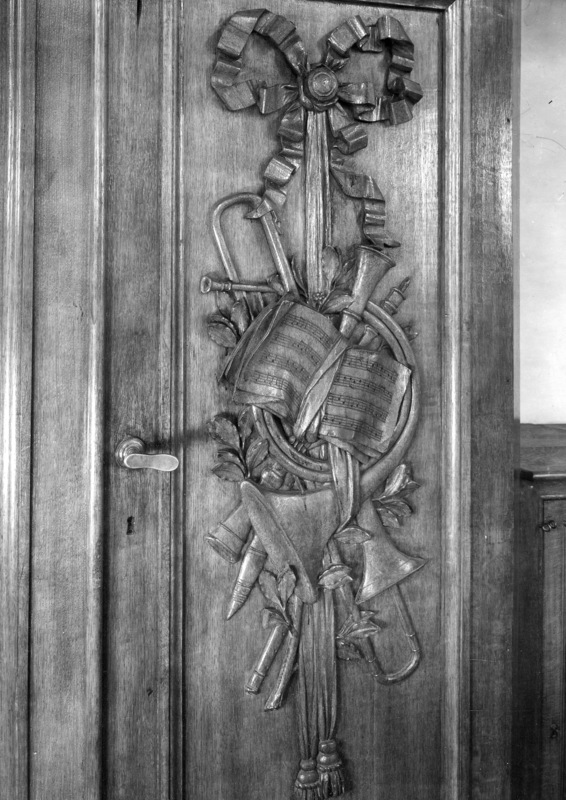
c. 1765—An anonymous chorale, Af hoeleyden oprunden er, is scored for 2 trombones, cornett, and organ (Collver 41).
1765—Vienna, Austria: Marianna Martines writes her Mass No. 4, where the two trombones double inner choral parts (Godt 35, 37).
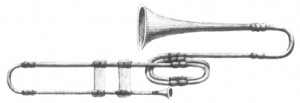 1765—Paris, France: Denis Diderot’s famous Encyclopédie includes an engraving of a trombone, labeled saqueboute (see facing image; public domain: wikimedia commons).
1765—Paris, France: Denis Diderot’s famous Encyclopédie includes an engraving of a trombone, labeled saqueboute (see facing image; public domain: wikimedia commons).
1765—North America: Trombones arrive in Moravian settlement of Bethabara, North Carolina (Guion, Trombone 126).
1765—Berlin, Germany: Christian Carl Rolle’s Das Herr Gott dich loben wir calls for 4 trombones (Collver 156).
1767-1791—Mozart includes trombone parts in 22 works. Most of them are from his Salzburg years and are either sacred music or opera. The most famous is the tenor trombone solo in his Requiem.
1767—In Salzburg, Michael Haydn writes Concertino in D, a double-concerto for alto trombone, horn, and orchestra (Haydn).
1767—Salzburg, Austria: The skeptical Archbishop locks 11-year-old Mozart in a room by himself to see if he can really compose without help from his father. Mozart writes the cantata Die Schuldigkeit des ersten Gebots, K 35, which uses solo alto trombone in Christ’s aria, “Jener Donnerworte Kraft” (for tenor voice, alto trombone, and strings).
1767—Vienna, Austria: Wenzel Thomas is appointed a trombonist at the Imperial Court, a position he holds until his death in 1775 (Wigness 42). Selfridge-Field has him employed until 1771 (Selfridge-Field, Caldara 150).
1767—Vienna, Austria: Gluck writes for the traditional trio of alto, tenor, and bass to evoke associations of ecclesiastical/supernatural in oracle scene of opera Alceste. The overture features relatively independent trombone parts and 3rd act features prominent obbligato for alto trombone.
1767—Bethlehem, Pennsylvania: A ledger for Bethlehem’s Moravian church records a purchase for a set of trombones from Herrnhut, Germany: “Christiansbrun for cash paid for a Set of Sack Buts.” The designation Sack Buts is unique among Moravian records (Carter, Trombone Ensembles of the Moravian).
1768—According to Guion, the earliest symphony with trombones in the orchestra is composed by Joseph Krottendorfer (Guion, Short History).
1768—Wachovia, North Carolina: The Moravian settlement in Wachovia receives their first set of trombones (treble, alto, tenor, and bass). The event is singled out for special mention in the congregation’s Memorabilia, or year’s summary of activities: “During the year we have received from Europe a set of trombones, and their use on solemn days and festivals has strengthened and edified our congregation” (Gombosi, A Day of Solemn Thanksgiving 8).
1768—Mozart’s Missa solemnis: “Waisenhauskirche Mass” uses trombones prominently, including an unaccompanied trombone trio opening to the “Agnus Dei” (Guion, Trombone 139).
1769—Vienna, Austria: Celebrations at the Ursuline convent in honor of the beatification of Angela Merici include special music provided by Ignaz Parhammer and the boys of the Waisenhaus, who perform the Mass with “trumpets, trombones, and flutes (Page, Convent Music 215).
1769—Vienna, Austria: Johann Georg Albrechtsberger writes Concerto for alto trombone (Wigness 22).
1769—Trombonist Thomas Gschladt, for whom both Michael Haydn and Leopold Mozart probably wrote, moves from Salzburg to Olmutz to assume position of Stadt Turmmeister (Director of City Music). Part of his job is apparently to train musicians to play at the local churches. Shortly after his arrival, he disputes with Anton Neumann, Kapellmeister of Olmutz Cathedral, about the quality of the musicians Gschladt is providing. Gschladt claims he needs more money in order to train them properly. Neumann, however, convinces church officials to get a stipend to train the musicians himself. Gschladt is so insulted that he vows never to play at the Olmutz Cathedral again. He does not play there for another 7 years (until the election of the new archbishop).
1769—Leipzig, Germany: Johann Friedrich Doles, J. S. Bach’s second successor in the Leipzig Cantorate, holds an audition for a vacancy in the Stadtpfeifer. He requires the 2 finalists to play a concerto for horn, oboe, or flute; the violin part of a trio; a concerted chorale on slide trumpet and bass viol; and a chorale on soprano, alto, tenor, and bass trombones” (Guion, Trombone 154). Regarding one of the candidates, the examiner writes, “He cannot manage the concerted Choral on the Zugtrompete, and has to do the best he can on an alto trombone.” Of the other he writes, “He played the simple Choral well on the discant, alto, tenor, and bass trombones” (Terry 36; Bate 230).
1769—Salzburg, Austria: at the time of Mozart’s appointment to the unpaid position of third Konzertmeister, court records show at least one trombone in the court orchestra. Additional trombone players would have been drawn from the Salzburg Stadtpfeifer (Eisen, Mozart’s Salzburg Orchestras).
c. 1770—Austria: Grassl composes Missa Pastoralis Ex C, which utilizes 2 trombones in an obbligato role (Mac Intyre 70, 609).
1770—Salem, North Carolina: At the Moravian settlement in Salem, upon the placement of the roof timbers of the Gemeinhaus, trombonists climb to the top of the building and play several chorales to mark the occasion (Gombosi, A Day of Solemn Thanksgiving 204).
1770-73—Salem (Baden), Germany: The organ in Salemer Münster, or Salem Abbey, includes a sculpture of a trombonist atop a set of pipes (see below detail; public domain) (Könner, Abb. 99).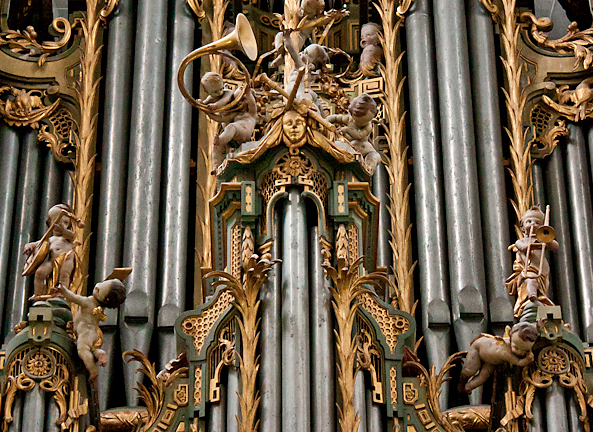
1771—Bethabara, North Carolina: Governor Tyron, on his way from Bethabara to a field outside Bethabara (where he is to hold maneuvers with his army) is accompanied by Moravian musicians, “our musicians leading and playing on the trombones and violins.” Later, at dinner, “several Healths were drunk, each being answered with a loud Hurra and the playing of a verse on the trombones by our musicians” (Gombosi, A Day of Solemn Thanksgiving 9).
1771—Salem, North Carolina: The Moravian settlement acquires instruments to form a trombone choir (Guion, Trombone 126).
1771—Lititz, Pennsylvania: The Moravian settlement acquires its first trombones. Written records show that the Elder’s Conference had decided that the instruments be used in a very specific manner: “By all means they [i.e., the trombones] should be put to use, but not for general use. Rather, they will be used only on communion days, at funerals, and to announce a homegoing. Our beginning here depends only upon arranging it so that the Brethren who will play them are introduced to it in a liturgical way and will practice at regular times under constant supervision and direction, for which direction Brother Grube was proposed” (Carter, Trombone Ensembles of the Moravian).
1771—Michael Haydn writes his Requiem, probably in honor of his patron, Archbishop Schrattenbach. First performed in the Salzburg Cathedral, it calls for 3 trombones (Chase 203).
1772—Vienna, Austria: Ignaz Ulbrich is appointed a trombonist at the Imperial Court, a position he holds until 1791, when he is given a pension and released (Wigness 42).
1772—Salzburg, Austria: Joseph Hafeneder, court violinist, composes Litany, which calls for 3 trombones (Eisen, Mozart’s Salzburg Orchestras).
1773—Versailles, France: Jean-Joseph Rodolphe composes Isaménor, one of the first French operas to call for trombone (Guion, Trombone 172).
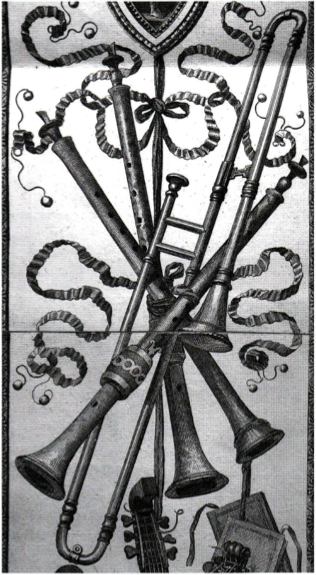 1774-77—Rome, Italy: Giovanni Volpato creates copper engravings of paintings by Giovanni da Udine found on the colonnade of the Loggia of Raphael in the Vatican, originally painted in 1517-1519 (see 16th century timeline). The instruments are grouped in trophies (or decorative clusters), the grouping that features trombone representing a shawm band, a common 16th century ensemble. Although the engravings by Volpato are generally considered good copies, they reflect some 18th-century characteristics, like the round stays on the trombone (see facing image; public domain) (Myers, Instrumental Trophies).
1774-77—Rome, Italy: Giovanni Volpato creates copper engravings of paintings by Giovanni da Udine found on the colonnade of the Loggia of Raphael in the Vatican, originally painted in 1517-1519 (see 16th century timeline). The instruments are grouped in trophies (or decorative clusters), the grouping that features trombone representing a shawm band, a common 16th century ensemble. Although the engravings by Volpato are generally considered good copies, they reflect some 18th-century characteristics, like the round stays on the trombone (see facing image; public domain) (Myers, Instrumental Trophies).
1774—Vienna, Austria: The Waisenhauskirche (“orphanage church”), which normally uses orphanage children for performance of sacred music, counts 3 trombonists among its residents (Edge).
1774—Paris, France: A trombonist by the name of Braun is hired to play Gluck’s opera, Iphigénie en Aulide (Guion, Trombone 173).
1774—Paris, France: Gluck composes the opera Orphée et Euridice, which calls for 3 trombones. They accompany the opening chorus for the funeral of Euridice, as well as playing in the scene that takes place at the gates of hell. The trombonists for the premiere are Braun, Moser, and Sieber (Guion, Trombone 173).
c. 1775—Bassano del Grappa, Italy: A ceiling fresco by Giovanni D’Antona in the Chiesa di San Sebastiano al Cappuccini features an angel trombonist playing from a balcony. D’Antona, a student of Girolamo Turro, was active in the second half of the 18th century and was from nearby Feltre (see detail and full image below; public domain).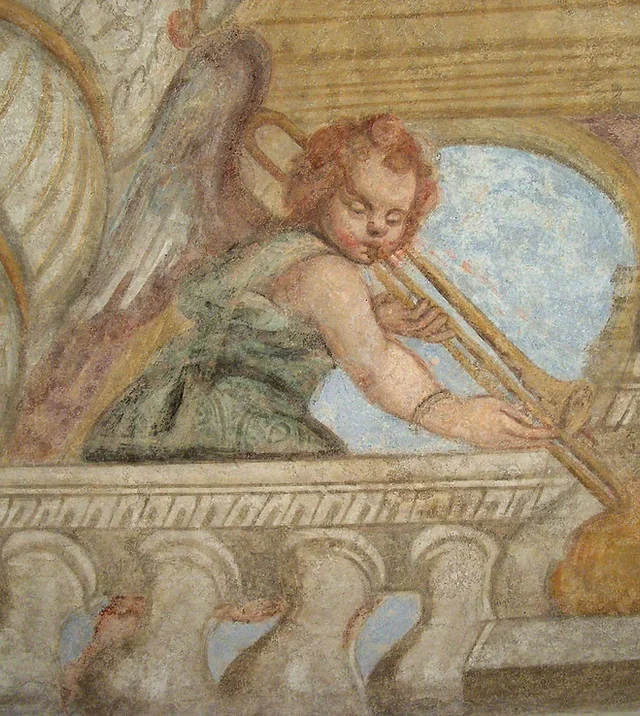
1776—Paris, France: Gluck composes the opera Alcest, which calls for trombones. They accompany only the supernatural scenes (Guion, Trombone 173).
1776—London, England: The London Concert of Ancient Music contains 1 trombone (Spitzer Ap B).
1776—Bologna, Italy: The San Petronio orchestra maintains 1 trombonist (Spitzer Ap B).
1777—Salzburg, Austria: In a letter to his son, Wolfgang, Leopold Moazrt writes the following about a performance of Michael Haydn’s Missa Sancti Hieronymi: “I liked the whole mass very much, as there were six oboists, three double basses, two bassoons and the castrato who has been taken on for six months at one hundred gulden a month. Ferlendis and Sandmayr played the oboe solos. The oboist at Lodron’s, a certain student, the chief watchman and Oberkirchner were the oboists in the orchestra. Cassel and the choirmaster Knozenbry were the double basses, seated near the organ and beside the trombones; Estlinger was there with his bassoon; Hofner and Perwein were seated beside the oboists on the violinists’ platform. What I particularly liked was that, since oboes and bassoons resemble very much the human voice, the tutti seemed to be a very strongly supported chorus of voices, as the sopranos and altos, strengthened by the six oboes and the alto trombones, admirably balanced the number of tenor and bass voices; and the pieno was so majestic that I could have easily done without the oboe solos. The whole affair lasted an hour and a quarter and I found it far too short, for it is really an excellent composition” (Anderson, The Letters of Mozart and His Family, 352). For a slightly different translation of the letter that also uses the term “alto trombones,” see Karl August Rosenthal, “The Salzburg Church Music of Mozart and His Predecessors.” The Musical Quarterly, Vol. 18, No. 4 (Oct., 1932), 559-577. According to Trevor Herbert, “In fact, the cover of the autograph score lists ‘3 Tromboni tutti obblig.’” (Herbert Trombone, 352).
1778—Bologna, Italy: the Teatro Comunale orchestra contains 1 trombone (Spitzer Ap B).
1778—France: Popular Neapolitan composer Niccoló Piccinni writes the opera Roland, which calls for trombones(Guion, Trombone 175).
1779—Paris, France: Gluck composes the opera Iphigénie en Tauride, which calls for trombones. They perform only while the Eumenides chase Orestes and during a funeral ceremony (Guion, Trombone 173).
1779—Paris, France: Gluck composes the opera Echo et Narcisse, which calls for trombones. They are used for a scene in hell and to accompany a chorus of evil spirits (Guion, Trombone 173).
1779—Bologna, Italy: The civic wind ensemble Concerto Palatino, after a 250-year existence, disbands. It had consisted of 4 cornetts and 4 trombones during most of its existence (Dickey, Cornett and Sackbut 99). In its place is formed an ensemble of standard military instrumentation: oboes, clarinets, horns, and bassoons. None of the original cornetts or trombones lose their jobs, they simply begin playing other wind instruments; this, along with other documentation, suggests that the players are already skilled on numerous wind instruments (Guion, Missing Link).
1780—French opera composer André Ernest Modeste Grétry composes Andromaque, which calls for trombones (Guion, Trombone 175).
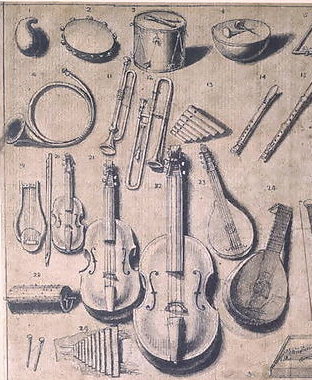 1780—Berlin, Germany: Polish-German artist Daniel Nikolaus Chodowiecki, famous for his miniatures and etchings, depicts trombone among a number of other musical instruments. The scale of the individual instruments appears to be off, as the trombone (which includes a slide-extension handle) is barely larger than the trumpet pictured next to it (see facing image; public domain).
1780—Berlin, Germany: Polish-German artist Daniel Nikolaus Chodowiecki, famous for his miniatures and etchings, depicts trombone among a number of other musical instruments. The scale of the individual instruments appears to be off, as the trombone (which includes a slide-extension handle) is barely larger than the trumpet pictured next to it (see facing image; public domain).
1780—Frenchman Jean Benjamin La Borde, writing about trombone, says, “It is much used in German church music. The manner of writing for them is the same as for voices, and the trombones have the same range….This instrument makes its greatest effect in funeral marches and, in general, sad music” (Guion, Trombone 73).
1780-1801—F. J. Haydn includes trombones in the following 8 works (according to Hoboken’s catalog): “Ad aras convolate” (1780); Il ritorno di Tobia (1784 revision); L’anima del filosofo, ossia Orfeo ed Euridice (1791); Der Sturm (The Storm) (1792); Die sieben letzten Worte unsers Erlösers am Kreuze (The Seven Last Words of Our Savior on the Cross) (1798); Die Schöpfung (The Creation) (1798); Te Deum (1800); Die Jahreszeiten (The Seasons) (1801) (Guion, Trombone 134). In addition, according to Landon, Haydn uses trombones in large choral works as often as possible. However, because there are no regular trombonists at Eisenstadt, Haydn’s works from this period lack the orchestral doublings and obbligatos common in trombone parts of nearby locations during this time period (Mac Intyre 709).
c. 1780-1795—Piacenza, Italy: A print by Antonio Bresciani reproducing a fresco by Ludovico Carracci in the Duomo of Piacenza includes an angel playing trombone (see below image; public domain).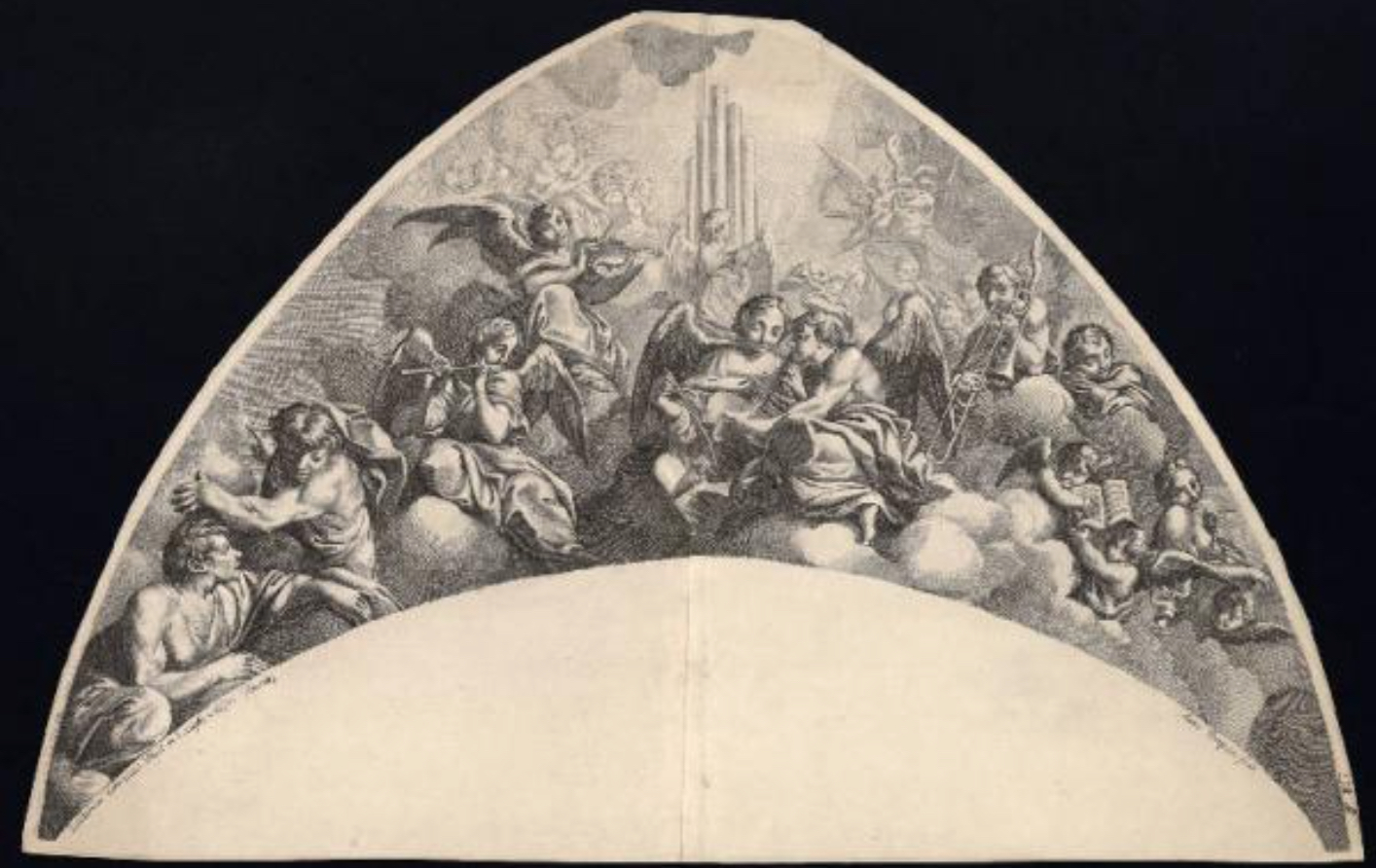
1781—Date marked on a rare soprano trombone owned by the Boston Museum of Fine Arts. The inscription on the instrument reads, “JOHANN JOSEPH SCHMIED MACHTS IN PFAFFENDORF 1781.” Soprano trombones never attract widespread use, possibly because of intonation difficulties (Young 104).
1781—France: Trombone is apparently unusual enough that a writer in the periodical Almanach musical mentions the instrument in the context of musical novelties, saying, “Mr. Gluck has successfully used in the orchestra some instruments that produce a very imposing effect. These instruments are called ‘trombones’; they furnish sustained and full sounds” (Guion, Trombone 177).
1781—France: Popular Neapolitan composer Niccoló Piccinni writes the opera Iphigénie en Tauride, which calls for trombone(Guion, Trombone 175).
1781—Vienna, Austria: Berlin critic Friedrich Nicolai witnesses a Trinity Sunday procession, beginning at St. Peter’s Cathedral, that includes a chorus accompanied by cornetts, 2 trombones, and 2 bassoons (Mac Intyre 14).
1781—Vienna, Austria: Berlin critic Fridrich Nicolai, though disappointed by much Viennese sacred music, is nevertheless impressed with a trombone obbligato he hears during a Mass: “On June 17th in the Kriegskirche or former Jesuit Church, I heard beautiful music for a Mass. Indeed it was in the modern taste but full of noble and new ideas….The Agnus Dei was accompanied by a thoroughly obbligato trombone which was played distinctly and intelligently” (Mac Intyre 98).
1781—Vienna, Austria: In a chapel at St. Augustine’s, Berlin critic Fridrich Nicolai hears a composition that he finds noteworthy, especially for its use of trombone: “Particularly moving for me was a beautiful, moderately slow aria sung by a choirboy who had a pure, gentle, flexible alto voice….The accompaniment was merely a concertante tenor trombone; there were no other instruments. Nonetheless, in this strange but simple combination there was so much to arouse a mysterious, solemn, and sublime feeling! These long drawn-out, gentle, always connected tones incited a silent amazement. Especially a few passages where the trombone gradually descended into the depths and held while the alto voice, which had had a pause of a few measures, again sang a soft, gradually intensifying long tone—these passages went right to the heart. I have heard nothing more appropriate for a long time” (Mac Intyre 99).
1781—Vienna, Austria: Mozart’s Idomeneo utilizes trombones in the famous oracle scene, accompanying the offstage voice of Neptune (Act III Scene 10). Mozart had written to his father, “The accompaniment to the subterranean voice consists of five instruments only, that is, three trombones and two French horns, which are placed in the same quarter as that from which the voice proceeds. At this point the whole orchestra is silent” (Anderson, Letters 703). This orchestration apparently led to a disagreement with Count Seeau, intendant of the court opera at Mannheim, about the extra expense of including trombones; Mozart writes, “In addition to many other minor rows with Count Seeau I have had a desperate fight with him about the trombones. I call it a desperate fight, because I had to be rude to him, or I should never have got my way” (Anderson, Letters 706). Interestingly, there is a version in which perhaps Mozart does not get his way: a Munich performing score includes only pairs of horns, clarinets, and bassoons, with no trombones (McClelland, Ombra 79).
1781—Salem, North Carolina: Records of the Moravian congregation note, “Concerning the solemn services for tomorrow, it was decided to hold the first meeting at 9 A.M., the Lovefeast at 3 P.M., and, at 8 P.M., the Singstunde with special instrumental music; the trombones will play during the first two services” (Gombosi, A Day of Solemn Thanksgiving 16).
1781/2—Vienna, Austria: The Burgtheater employs trombones for performing in revivals of Gluck’s Orfeo ed Euridice, Alceste, and Iphigenie auf Tauris (Edge).
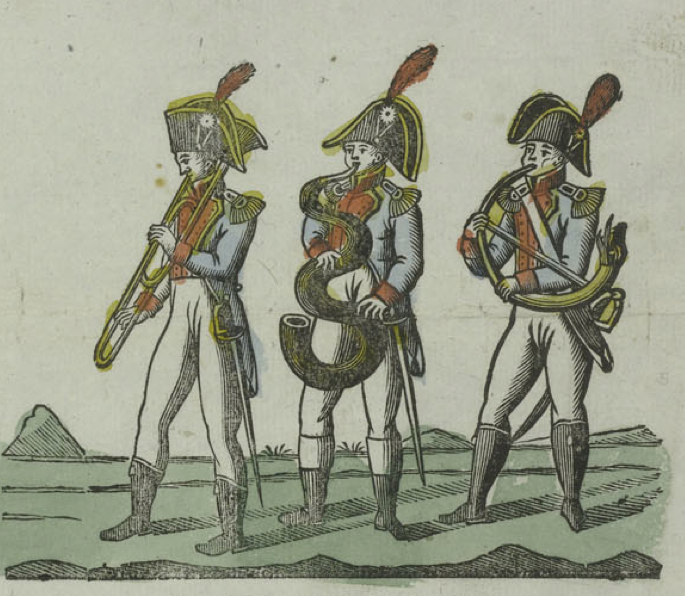 1781-1854—Amsterdam, Netherlands: Military Music, a catchpenny print produced by Erve H. Rijnders, includes a rear-facing trombone (see above detail; public domain) (Catchpenny Prints of the Dutch Royal Library).
1781-1854—Amsterdam, Netherlands: Military Music, a catchpenny print produced by Erve H. Rijnders, includes a rear-facing trombone (see above detail; public domain) (Catchpenny Prints of the Dutch Royal Library).
1782—Bethlehem, Pennsylvania: The Moravian trombone choir performs for General George Washington on his visit to Bethlehem (Carter, Trombone Ensembles of the Moravian).
1782—Paris, France: At the Paris Opéra, 2 players, Braun and Nau, are assigned to double on trumpet, horn, and trombone (Carse, Orchestra 40).
1782—Warsaw, Poland: An inventory of the Lutheran Church of the Holy Trinity shows the church owns 5 trombones (Goldberg, Music in Chopin’s Warsaw 271).
1782—Brno, Czech Republic: An instrumental ensemble of all female performers at the Cistercian convent at the outskirts of Brno includes a female trombonist (Ottilia Kreitmayerinn), along with three hornists (Shifrin, Women’s Orchestra).
1782—Mainz, Germany: There are 3 trombones in the Kurfürstliche Hofkapelle orchestra (Guion, Trombone 154).
1782—Sweden: Johann Gottlieb Naumann writes an opera, Cora och Alonza, that includes trombone (Guion, Trombone 165).
1782—Naples, Italy: Trombonist Antonio Mariotti, formerly of Bologna, becomes trombonist at San Carlo, the royal theatre. Mariotti later moves to Paris, then to England, where he remains that country’s leading trombonist for more than 30 years (Guion, Missing Link).
1782/3—Vienna, Austria: The Burgtheater employs 3 trombones for playing Gluck’s Alceste (Edge).
1782/3—Mozart calls for 3 trombones in his C Minor Mass.
1783—Vienna, Austria: Emperor Joseph II issues a decree requiring, among other things, that musical expenses at all Viennese churches be disclosed. The resulting list shows that, of the 32 Viennese church orchestras for which orchestra members are listed by name, 10 include a pair of trombones. By comparison with other winds, only 2 orchestras include oboes, only 1 a bassoon, and none include horns (Edge).
1783—French opera composer André Ernest Modeste Grétry composes Alexandre aux Indes, which calls for trombones (Guion, Trombone 175).
1783—Salem, North Carolina: Trombones accompany the Te Deum on New Year’s Day at the Moravian settlement (Gombosi, A Day of Solemn Thanksgiving 208). Later the same year, at “A Day of Solemn Thanksgiving,” a Moravian 4th of July patriotic celebration, records of the event mention, “The congregation was awakened with trombones, and at the beginning of the Preaching Service, the Te Deum was sung with the joyous pealing of the trombones” (Gombosi, A Day of Solemn Thanksgiving 42). An order to Herrnhut, Germany is also placed the same year for “a set of trombones,” with the instruments arriving 2 years later (Gombosi, A Day of Solemn Thanksgiving 209).
1784—London, England: According to Charles Burney, there is considerable difficulty locating 6 trombonists for the upcoming Handel Festival: “In order to render the band as powerful and complete as possible, it was determined to employ every species of instrument that was capable of producing grand effects in a great orchestra, and spacious building. Among these, the sacbut, or double trumpet, was sought; but so many years had elapsed since it had been used in this kingdom, that, neither the instrument, nor a performer upon it, could easily be found. It was, however, discovered, after much useless enquiry, not only here, but by letter, on the continent, that in his Majesty’s military band there were six musicians who played the three several species of sacbut; tenor, base, and double base” (Burney Westminster 7). Burney’s roster of performers, under the heading TROMBONI, or SACBUTS, includes 6 names, along with the following note: “These performers played on other instruments, when the sacbuts were not wanted” (Burney Westminster 19). The chart of the orchestral layout has the trombones labeled Trombonis (Burney, Westminster).
1784—London, England: At the Handel Festival, Charles Burney comments on “tuneful blasts of trumpets and sacbuts in the Dead March” from Saul (Burney Westminster 33). He also speaks of the augmentation of the orchestra with trombones in Saul: “Indeed, the powerful manner in which this subject was delivered, singly, by the other parts, as well as the ingenuity of the accompaniment, and united force of the whole band, augmented throughout by the tromboni, when every voice and every instrument was employed, must have astonished, by the novelty of the effects, not only the unlearned lovers of Music, but the most scientific and experienced Musicians present” (Burney, Westminster 104).
1784—London, England: One listener at a Handel Festival performance who is apparently unfamiliar with trombones writes in the margin of his program that they are “something like bassoons with an end like a large speaking trumpet” (Guion, Trombone 143).
1784—London, England: At the Handel Festival, Dr. Sylas Neville is impressed by “so many voices, such prodigious kettle drums, that most powerful instrument the trombone & the loftiness of the place so well adapted to give the highest effect to musical sound” (Neville 321).
1784—London, England: At the Handel Festival, Thomas Marsh says the following about the performance of Zadok the Priest: “This symphony with its beautiful modulation having continued some time, at length the whole force of the orchestra with all the voices, full organ, trumpets, trombones, double drums, etc. burst upon us all at once in the words—‘Zadok, the priest’—the force and effect of which almost took me off my legs, and caused the blood to forsake my cheeks” (Johnstone).
1784—Berlin, Germany: Critic Friedrich Nicolai comments on the trombone’s use in Northern Germany relative to Austria and Bavaria: “In our region [Northern Germany] the trombone has become almost totally uncommon for full-voiced music. In Austria and Bavaria this instrument is still very much in use and well played, especially in the church. Gluck has used it in his operas and ballets, often with the most successful result” (Mac Intyre 709).
1784-5—Württemburg, Germany: Christian Schubart, in his Ideen ze einer Aesthetik der Tonkunst, expresses strong opinions about trombone: “This instrument is entirely ecclesiastical…The instrument has never been profaned throughout the millennia, but rather has always remained a heritage of God’s temple…In our days, however, they have been desecrated for the service of opera, and the trombone is no longer the property of God’s worship. It is also used now with great effect in the choruses of large operas…. The trombone’s tone is piercing and much thicker than a trumpet’s. Sustained notes can be expressed on this instrument as on no other in the world….Not only church music has now been composed for trombones, but also concertos, sonatas, and solos, and these always have an admirable effect. Only the Catholics in Germany still favor this instrument and unless help is forthcoming from Vienna, we must fear the gradual and complete loss of this instrument….Our music directors should take into preferential consideration the reawakening of this divinely authorized instrument, and to urge geniuses in its favor, and thereby return the thunderous sound of the trombone, which it had in Solomon’s time. Meanwhile, there are nevertheless still outstanding trombonists in Saxony and Bohemia. But it is certain that the sound of the trombone in truly intended for religion and not at all for secular use” (Guion, Trombone 83).
c. 1785—Carl Ditters von Dittersdorf, colleague and personal friend of both Mozart and Haydn, writes his Requiem in C minor. The work calls for 3 trombones that double the lower vocal parts (Chase 195).
1785—Nazareth, Pennsylvania: The Moravian community in Nazareth acquires a set of trombones (Carter, Trombone Ensembles of Moravian).
1785—Vienna, Austria: 2 trombones are employed for a concert put on in Vienna’s Kärntnertortheater by the Tonkünstler-Societät (Edge).
1785—France: popular Neapolitan composer Niccoló Piccinni writes the opera Pénélope, which calls for trombones(Guion, Trombone 175).
1786—Edinburgh, England: a military concert includes trombones (Guion, Trombone 146).
1786—Paris, France: M. Louis, an employee of the Paris Opéra, is specifically instructed to buy German trombones for the organization (Carse, Orchestra 41).
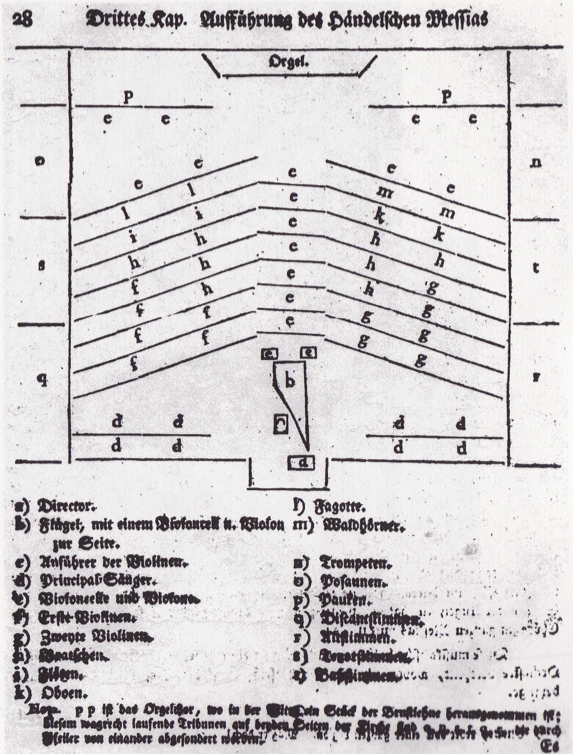 1786—Berlin, Germany: 6 trombones are added to the first German performance of Handel’s Messiah. A contemporary diagram shows the orchestra’s seating plan for the performance, with the trombone section, labeled O, seated on the upper-left edge (see above image; public domain) (Bowles, Timpani 262; Guion, Trombone 155).
1786—Berlin, Germany: 6 trombones are added to the first German performance of Handel’s Messiah. A contemporary diagram shows the orchestra’s seating plan for the performance, with the trombone section, labeled O, seated on the upper-left edge (see above image; public domain) (Bowles, Timpani 262; Guion, Trombone 155).
1786—Leipzig, Germany: Handel’s Messiah is conducted by Johann Hiller. According to a review of the performance by a local newspaper, Leipziger Zeitung, “The inhabitants of the city had the pleasure last Friday of hearing the great [and] excellent piece by Handel, The Messiah, in the University Church in the evening while it was lit up, performed by a large orchestra and executed to the best effect….The instrumental ensemble consisted of 22 first and 21 second violins, 13 violas, 12 cellos and 12 basses, 8 flutes, 10 oboes, 10 bassoons, 8 hunting horns, 7 trombones, 6 trumpets and a pair of kettledrums….The performance went off uncommonly well” (Bowles, Timpani 460).
1787—Krems, Austria: Martin Johann Schmidt paints a fresco in Pfarrkirche St. Veit (St. Vitus parish church) that features numerous music-making angels, including an angel playing what appears to be a trombone (see detail and full image below; special thanks to Kellyn Haley).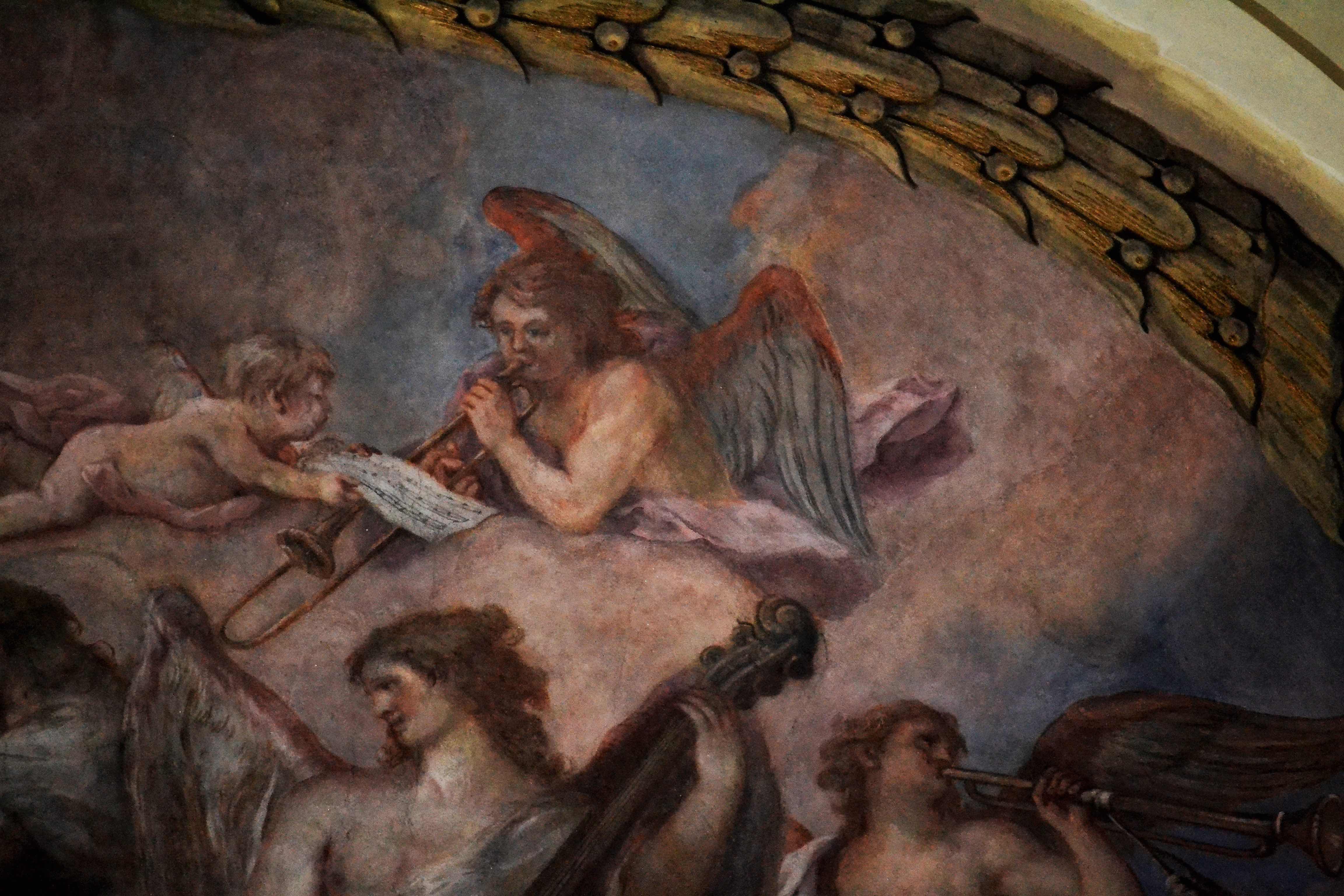
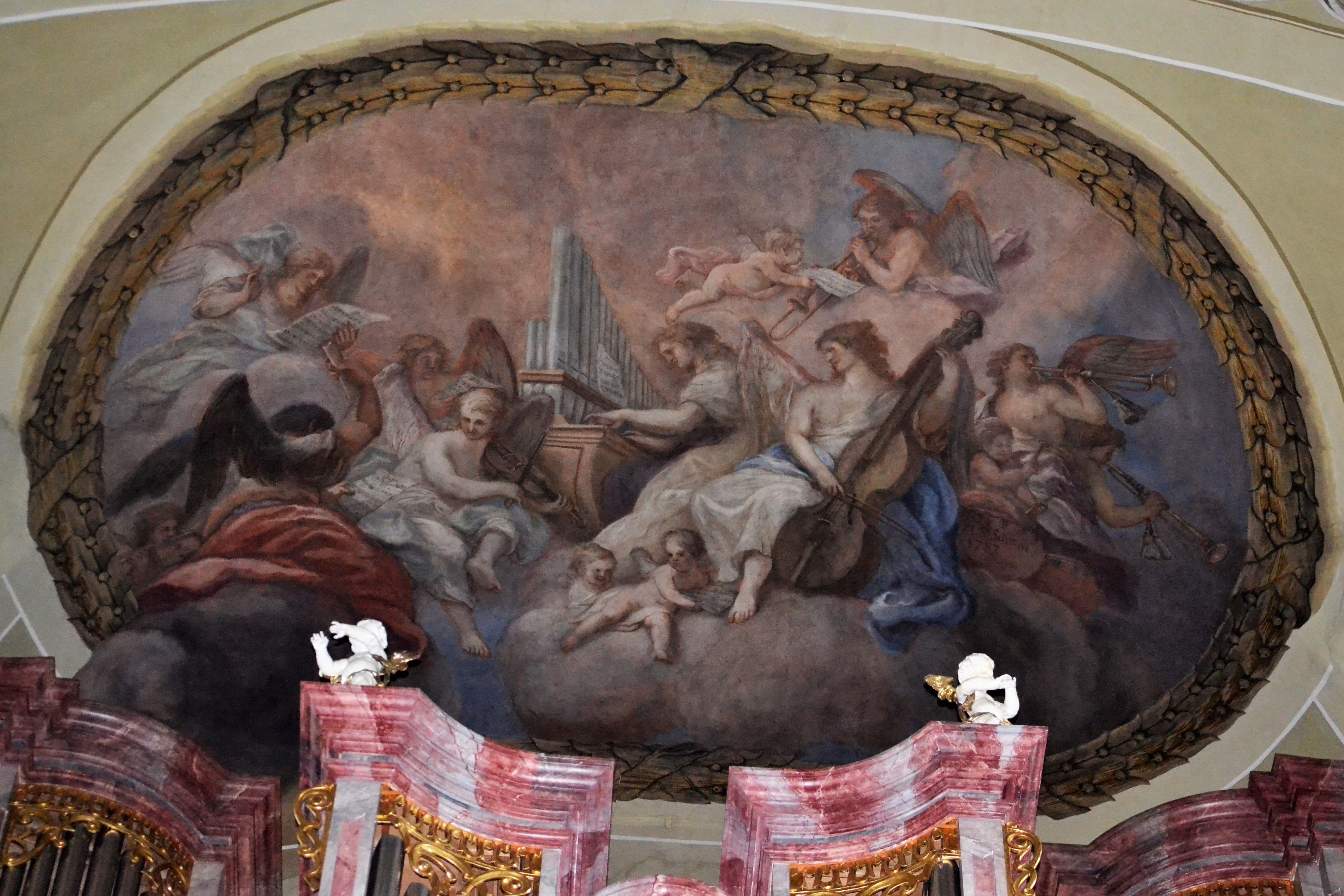
1787—Sweden: Johann Christian Friedrich Haeffner writes an opera, Electra, that calls for trombone (Guion, Trombone 165).
1787—Liverpool, England: A music festival is held that includes one trombone (Spitzer Table 8.4).
1787—Berlin, Germany: The Orchestra of the King of Prussia includes 3 trombones (Herbert, Trombone 333).
1787—Vienna, Austria: Carl Ditters von Dittersdorf’s opera, Die Liebe im Narrenhaus, contains the following reference to trombone: “Believe me, the devils are often much sooner moved than many human beings. There are a great many thick-eared creatures—especially among human beings—on whom not even a braying trombone can make an impression” (Jander, The ‘Kreutzer” Sonata as dialogue).
1787—Vienna, Austria: Mozart employs trombones in Don Giovanni, particularly for ecclesiastical/supernatural associations. Trombones are left out of the score until Commendatore’s statue comes to life.
1787—Paris, France: Gluck’s last composition, “De Profundis,” utilizes 3 trombones.
1787—England: Samuel Arnold uses 4 trombones in his oratorio, Redemption (Guion, Trombone 147).
1787—Vienna, Austria: Johann K. Ulbrich is employed as trombonist at the Imperial Court (Wigness 42).
1787—Berlin, Germany: 3 trombones are employed in the Königliche Kapelle (Guion, Trombone 154).
1787—France: Antonio Salieri composes the opera Tarare, which calls for trombones (Guion, Trombone 175).
1787/8—Vienna, Austria: the Burgtheater employs 3 trombones for 7 performances of Salieri’s Axur, re d’Ormus (Edge).
1788—France: Luigi Cherubini composes Demophoon, an opera that utilizes trombone (Guion, Trombone 175). He later writes numerous other operas with trombones, including Lodoiska (1791), L ‘hotellerie portugaise (1798), Les deux journées (1800) Epicure (1800), Anacréon (1803), and Achille a Scyros (1804) (Guion, Trombone 192).
1788—Vienna, Austria: Antonio Salieri uses trombones in his Mass in D to double alto and tenor vocal lines (Cameron 83).
1789—At the Erdödy Court, a concert is given that includes a solo work for trombone, played by Herrn Joseph Rotter (Whitwell, Classic 39).
1789—Rome, Italy: The occupying French replace the Concerto Capitolino, an ensemble consisting of 2 cornetts and 3 trombones, with a military band. The ensemble, which had led Papal processions through Rome, had been one of the latest examples of the coupling of trombones with cornetts (Baines, Brass 118).
1789—Paris, France: The Concert Spirituel hires its first full-time trombonist (Guion, Trombone 177).
1789—France: the Théatre de la rue Feydeau hires its first full-time trombonist (Guion, Trombone 177).
1789—Paris, France: The Paris Conservatory’s original faculty includes Philippe Widerkehr, a trombonist (Whitwell, Classic 171).
1789—Mozart includes trombones in his orchestration of Handel’s Messiah.
1789—England: Samuel Arnold uses 4 trombones in his oratorio, The Triumph of Truth (Guion, Trombone 147).
1790—Hope, New Jersey: The Moravian congregation purchases a set of trombones (Carter, Trombone Ensembles of the Moravian).
1790—Vienna, Austria: Johann Georg Albrechtsberger writes his treatise, Sämmtliche Schriften über Generalbass (Methods of harmony, figured bass, and composition), wherein he says the following about trombone: “The first trombone should go with the alto, the second with the tenor, and the third, which is now scarcely in use, with the vocal bass. This instrument requires rather slow than quick notes, and admits of but few forced notes, which the trumpets alone produce readily. A quick movement must never be given to it in obligato pieces” (Albrechtsberger 264). He also writes, “The Trombone (Posaunen, tromboni) are of three kinds: bass, tenor, and alto. In every position of the slide, the trombone yields four, five, or six different sounds….The compass of the bass trombone is from E1, through every semitone, up to G3; and of the alto trombone from F2 up to E-flat4. Braun and Frölich have written methods or schools. Ahlsdorf, Bolke, Braun, Dueller, Frölich, Hörbeder, Micke, Schmitt, Seeger, Segner, Ulbrich, etc. have handled this instrument skillfully” (Albrechtsberger 290).
1790—Stockholm, Sweden: The royal chapel’s orchestra includes 3 trombonists (Guion, Trombone 165).
1790—France: An enormous festival takes place on the first anniversary of the fall of Bastille in which the commander in chief of the new French army, members of the Constituent Assembly, and the king swear allegiance to the new order. It concludes with Gossec’s Te Deum, which utilizes trombones in the “Judex crederis” movement (Guion, Trombone 182).
c. 1791—Ignaz Pleyel writes several orchestral works that include trombone: Symphony in B-flat, Symphony in e-flat, and Symphony in A (Guion, Trombone 268).
c. 1791—Haydn calls for 2 trombones in L’anima del filosofo (Spitzer Table 1.1).
1791—Berlin, Germany: 4 trombones are included in the Berlin Kapelle (Spitzer Ap C).
1791—Vienna, Austria: Mozart employs trombones prominently in Magic Flute, particularly for ecclesiastical/supernatural associations.
1791—Vienna, Austria: Mozart writes his Requiem, which includes the famous “Tuba Mirum” solo. The first 18 measures are composed by Mozart; the following portion is added later by Süssmayr (Guion, Trombone 139).
1791—Paris, France: The Almanach general praises a “…trombonist M. Mariotti, astonishing for his precision on this instrument, of which the pleasing effect was formerly unknown in France” (Guion, Trombone 162).
1791—Paris, France: 1 trombone is included in the Theatre de Monsieur (Spitzer Ap C).
1791—St. Petersburg, Russia: Nachal’noe upravlenie Olega, an opera composed by Giuseppe Sarti, Carlo Canobbio, and Vasily Pashkeevich, is published. It includes 2 trombones (Guion, Trombone 164).
1791—St. Petersburg, Russia: Carlo Canobbio writes a military march for 4 trumpets, trombone, and triangle (Tarr, East Meets West 23).
1791-1803—Paris, France: Étienne Méhul writes at least 12 operas that call for trombone (Guion, Trombone 193).
1792—Bethlehem, Pennsylvania: A double choir of trombones observes the passing of Bishop Gottlieb Spangenberg (Carter, Trombone Ensembles of the Moravian).
1792—Sweden: Joseph Martin Kraus writes Begravningskantat over Gustav III, which includes trombone (Guion, Trombone 165).
1792—Encyclopaedia Londoniensis describes the presence of trombones as “a nuisance to all lovers of pure harmony and refined tones” (Wills, Orchestra 163).
1792—Pleyel’s Sinfonia concertante in F Major (Ben 113), which includes trombone, receives excellent reviews for its London premiere. It is not published until 1794 (Guion, Trombone 149, 268).
1792—Paris, France: Trombonists A. Widerkehr and Pierre Marciliac are members of the Theatre du Palais orchestra (Guion, Trombone 190).
1792—London, England: 1 trombone is included in the London Professional Concert (Spitzer Ap C).
1792—Marseilles, France: A combination trumpet/trombone player is included in the Theatre National (Spitzer Ap C).
1792—Paris, France: 2 trombones are included in the Grand Theatre orchestra (Spitzer Ap C).
1792—Paris, France: 4 doublers on trumpet/trombone are included in the Paris Opera orchestra (Spitzer Ap C).
1793—Paris, France: The government adds 13 new faculty members to the Paris Conservatory, including trombonist Pierre Marciliac, who remains on the faculty until 1802 (Guion, Trombone 190).
1793—Pleyel writes the French Revolution orchestral piece, La Révolution du 10 aout 1792, ou Le tocsin allégorique, which requires trombone (Guion, Trombone 187).
1793—Vienna, Austria: Clemens Messerer is appointed as a trombonist at the Imperial Court. He holds the position until 1807 (Wigness 41).
1793—Vienna, Austria: Anton Michael Ulbrich is appointed as a trombonist at the Imperial Court. He holds the position until his death in 1830 (Wigness 42).
1793—Bologna, Italy: The San Petronio orchestra includes 1 trombone (Spitzer Ap C).
1793—Paris, France: Pierre Marciliac is listed as a trombonist at the Comédie Italienne (Guion, Trombone 190).
1793—Paris, France: A concert is performed to demonstrate the Paris Conservatory’s accomplishments. Included are 5 works that require trombone—2 works by Catel and 3 by Gossec (Guion, Trombone 190).
1793—London, England: Covent Garden orchestra includes 1 trombone (Spitzer Ap C).
1793—London, England: Salomon’s Concert orchestra includes 1 trombone (Spitzer Ap C).
1793—Paris, France: François Joseph Gossec’s opera La triomphe de la république calls for trombone (Guion, Trombone 192).
1794—England: Orchestra at the Worcester Festival includes 2 brass players who are expected to double on trombone and horn (Carse, Orchestra 40).
1794—Othon Vandenbroek, a Flemish hornist, describes current use of trombone: “None of these three plays the melody, but rather chords prepared in heart-rending or gloomy pieces. Only the clefs distinguish the different trombone parts” (Guion, Trombone 78).
1794—London, England: J. Doane compiles a city music directory. The listing includes the names of 6 trombonists: John Dressler—double bass and trombone, Drury Lane Theatre and the Abbey; Franks—trombone at the Abbey and Ranelagh; Mariotti—trombone at the Oxford Meeting, 1793; Schubert, Geo. Fredk.—trombone and bassoon, Drury Lane Oratorios and the Abbey; Zinck—trombone in the Queen’s Band and the Abbey; Zwingman, John—violin and trombone, the Guards Second Regiment (Guion, Trombone 147).
1794—Paris, France: Paris Conservatory concert features several works that include 3 trombones (Whitwell, Classic 181).
1795—Paris, France: Decree officially establishing the Paris Conservatory indicates a staff of 115 artists, including one trombone teacher and 3 performers on trombone (Guion, Trombone 191).
1795—Paris, France: A document stipulates the number of trombone students at the Paris Conservatory as 3 tenor trombones and 2 bass trombones (Whitwell, Classic 184).
c. 1795—Paris, France: Trombonist André Braun publishes Gamme et Méthode pour let Trombones, the first complete modern method book written specifically for trombone. It also contains the first description of a tenor trombone in B-flat with seven chromatic positions (see below image; public domain). It specifically states that the alto trombone is in E-flat, the tenor and bass in B-flat. An influential method book–it informs several later methods, including Fröhlich and Nemetz–the method book also provides an alto trombone position chart clearly showing an instrument in E-flat (see Alto Trombone History Timeline). Editions of the method are subsequently published in German and Italian (Weiner, Braun; Weiner, Braun Revisited; Dudgeon 194).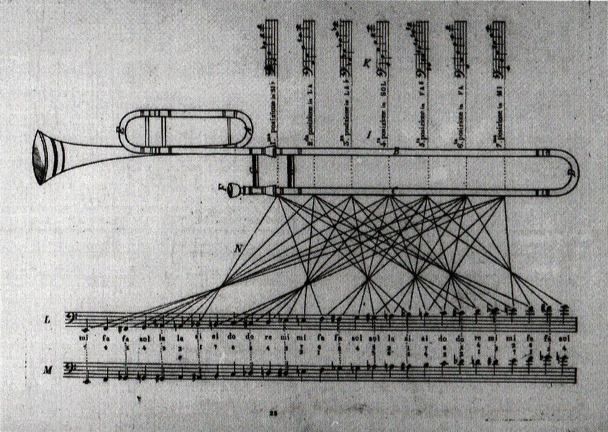
c. 1795—France: The earliest book of etudes written specifically for trombone, François René Gebauer’s Six trios pour trios trombones extraits de 50 leçons pour la trombone bass, alto & tenor, is published.It is issued as a companion to André Braun’s Gamme et Méthode pour let Trombones.
1795—Joos Verschuere-Reynvaan, in his Dutch dictionary, Muzijkaal Kunst-Woordenboek, defines trombone: “Trombone: (a wind instrument known by that name), being a kind of slide trumpet, which is being used at joyful occasions in churches, etc. and in Germany by the city musicians on towers” (Guion, Trombone 79).
1795—Paris, France: François Joseph Gossec writes the French Revolution orchestral piece Serment républicaine, which calls for trombone (Guion, Trombone 187).
1796—Paris, France: François Joseph Gossec writes a French Revolution orchestral piece called Hymne guerrier, which requires trombone (Guion, Trombone 187).
1796—Dresden, Germany: Carl Ditters von Dittersdorf calls for 3 trombones in his opera Ugolino (Guion, Trombone 160).
1796—Leipzig, Germany: Johann Hiller, cantor at St. Thomas Church (a position previously held by J.S. Bach), writes to lexicographer Gerber about the instrumental forces at his disposal: “Do come to see us sometime so that I can let you listen to the last but greatest work of Mozart, the Requiem, performed by my pupils! You will be astonished if you were to see my trumpeters, timpanists, horn-players, oboists, clarinettists, bassoonists, violinists and bass players, all in black coats, at which time I would still have a chorus to spare of 24 singers; even the trombones are now played in church by my students” (Bowles, Timpani 235).
1796—Paris, France: Comédie-Italienne orchestra includes a trombone (Spitzer Ap C).
c. 1797—Paris, France: Théatre de la rue Feydeau adds a second trombonist to its orchestra (Guion, Trombone 230).
1798—London, England: Composer Michael Kelly uses trombone in his opera Blue Beard (Guion, Trombone 147).
1798—Rome, Italy: The Concerto Capitolino, a longstanding ensemble comprised of 6 cornetts and 6 trombones, is disbanded by Napoleon, who replaces it with a military band (Dickey, Cornett and Sackbut 100).
1799—Paris, France: Jean-Baptiste Rey conducts a revival of Gluck’s Armide. Composer C.H. Plantade, armed with a score of the work, notices that various trombone lines have been added in the performance. Plantade then complains in a letter to the Courrier des spectacles, saying, “masterpieces should be left alone.” Rey writes in his defense that he has no problem with enjoying “the full sound-potential” of his ensemble (Charlton).
1799—London, England: Composer Michael Kelly calls for trombone in the incidental music to Richard Brinsley Sheridan’s play, Pizzaro (Guion, Trombone 147).
1799—Le Mans, France: A civic wind band called the Musique municipale du Mans includes 2 trombones (Whitwell, Classic 150).
1799—Vienna, Austria: According to eyewitness G. J. Berwald, a performance of Haydn’s Creation is conducted by the composer at the Imperial Burgtheater: “When we entered, we saw that the stage proper was set up in the form of an amphitheater. Down below at the forte-piano sat Kapellmeister Weigl, surrounded by the vocal soloists, the chorus, a violoncello and a double bass [as continuo]. At one higher level stood Haydn himself with his conductor’s baton. Still on a higher level on one side were the first violins, led by Paul Wranitzky and on the other the second violins, led by his brother Anton Wranitzky. In the center: winds and double basses. In the wings, more double basses; on higher levels the wind instruments, and at the very top: trumpets, kettledrums and trombones. That was the disposition of the orchestra, which, together with the chorus, numbered some 400 persons. The whole [performance] went off wonderfully” (Bowles, Timpani 470).
late 1700s—Use of crooks gradually disappears. Fixed tubular braces replace flat detachable stays.
c. 1800—Bologna, Italy: A drawing attributed to Francesco Rosaspina, after Ludovico Carracci’s Paradise (see 1616 in the timeline), includes an angel playing trombone (see below image; public domain).![]()
c. 1800—Pairs, France: Porte Dauphine, A print by Charles Percier (1764-1838) from Album Fontainebleau, includes at least two trombones (see below image; public domain) (source: Réunion des musées nationaux).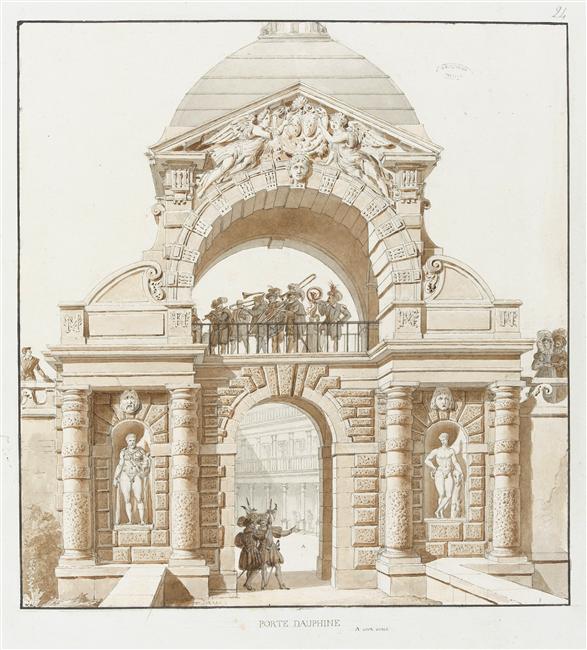
c. 1800—Venezuela: The music ensemble of a comic theatre company includes a trombone (Mendoza de Arce 454).
c. 1800—Frankfurt am Main, Germany: Philipp Jakob Döring publishes a sheet of cut-outs of military musicians that includes a rear-facing trombone (see below detail; public domain) (German National Museum).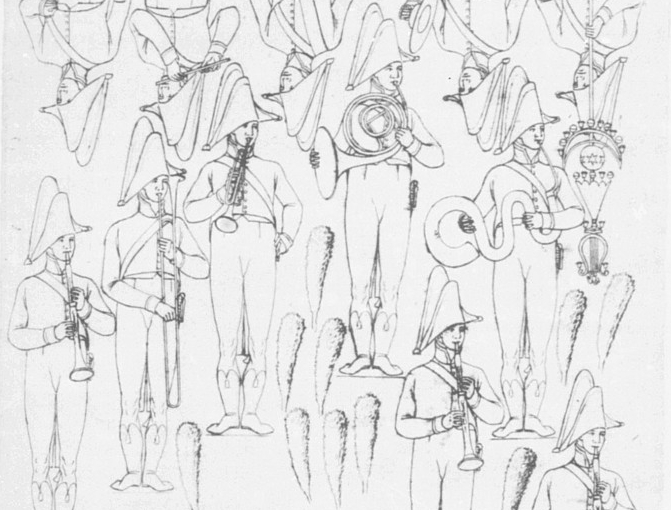
c. 1800—Germany: A print of military musicians entitled Turkische Musick der K. Baierischen Grendier Garde, now held in the German National Museum, includes a rear-facing trombone (see below detail; public domain).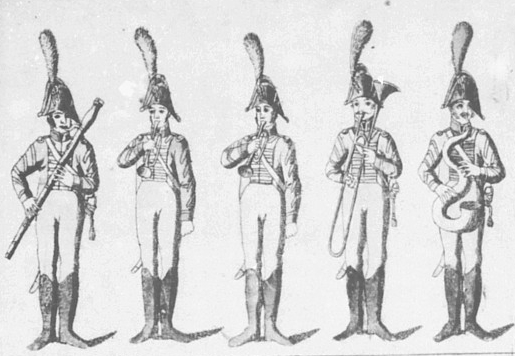
1800—Paris, France: Etienne Nicolas Méhul writes a French Revolution orchestral piece called Chant nationale du 14 juillet 1800, which requires trombone (Guion, Trombone 187).
1800—Berlin, Germany: A performance of Mozart’s Requiem is given with all 3 trombone parts performed by trombonists (but see 1805) (Guion, Trombone 155).
1800—A new military symbolism for trombone begins to emerge. For example, in Cherubini’s opera, Les deux journées (1800), and Dalayrac’s opera, Léhéman (1801), the trombone’s use almost always coincides with appearance of soldiers (Guion, Trombone 194).
Late 18th-early 19th century—Paris, France: “Un tromboniste,” a portrait by Henri-François Riesener, features a musician with a rear-facing trombone (see below image; public domain; Detroit Institute of Arts). Special thanks to Tassos Dimitriadis.